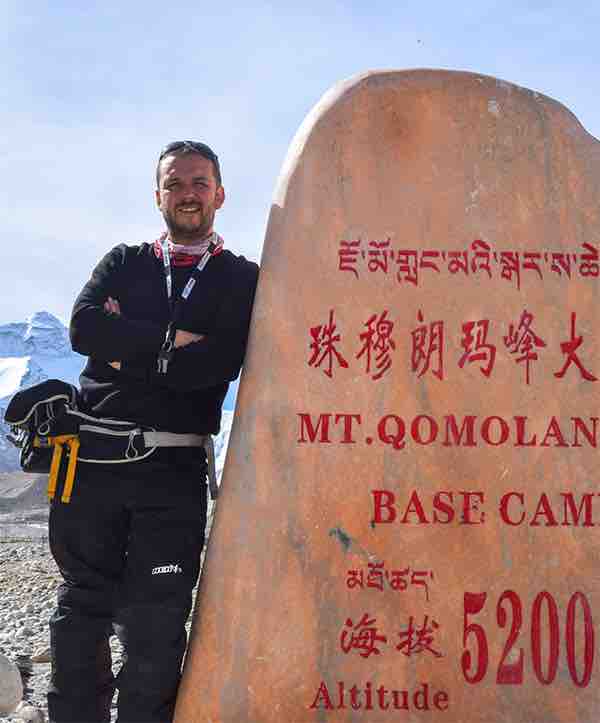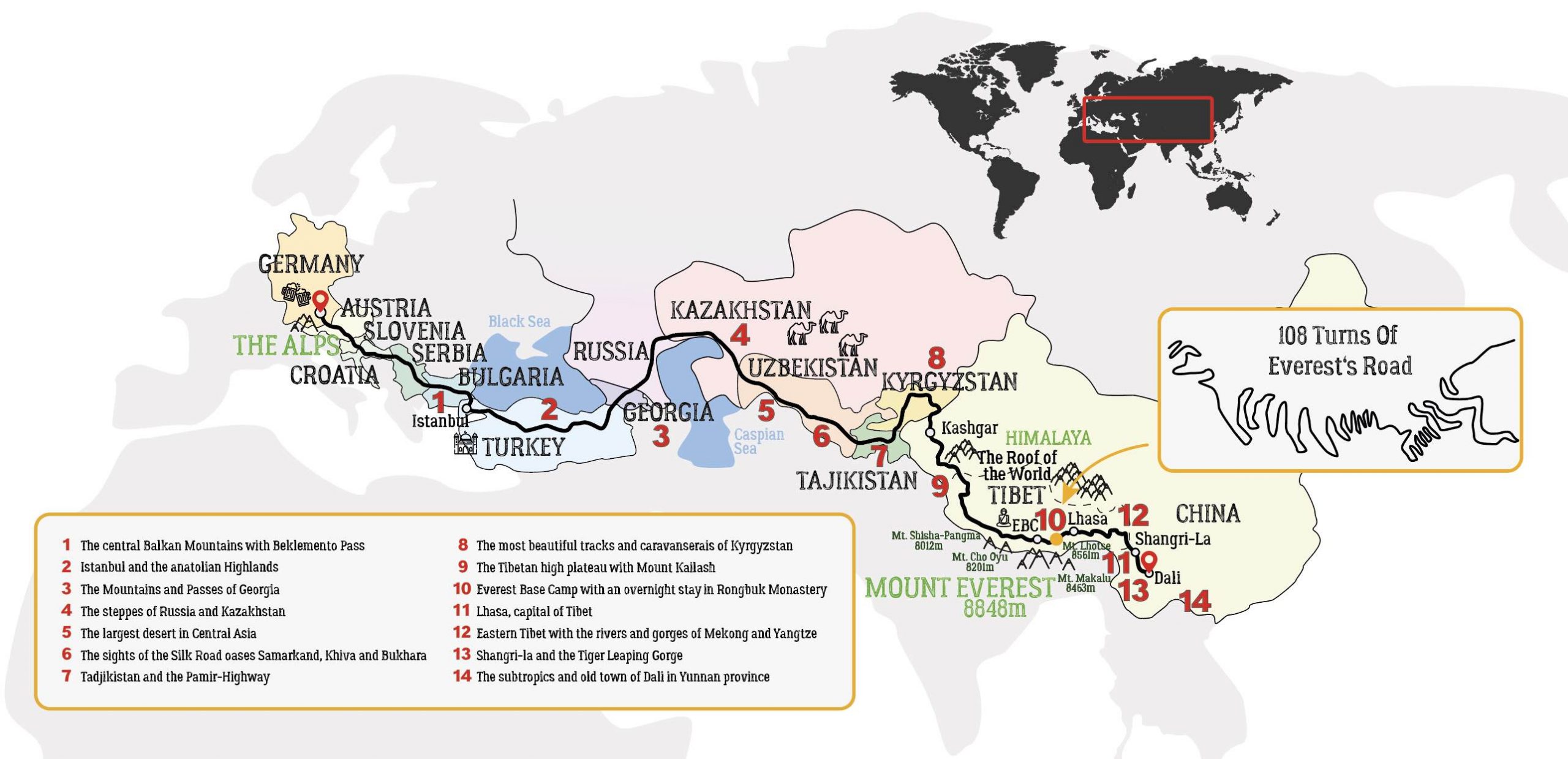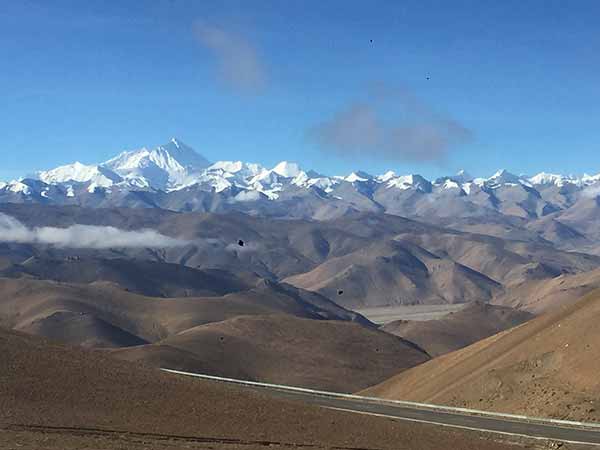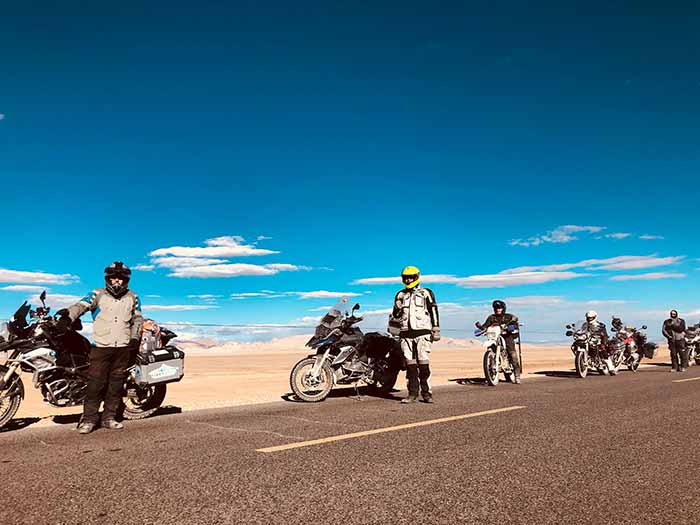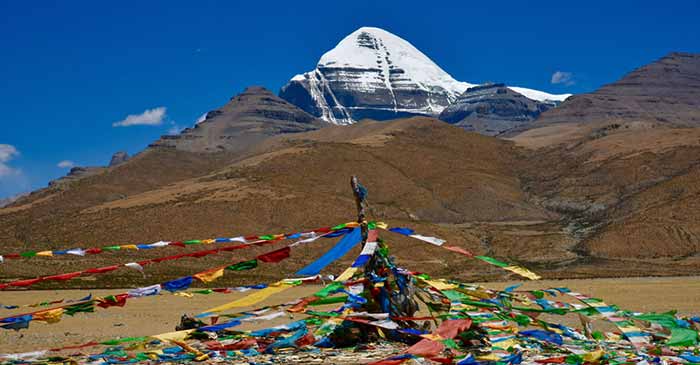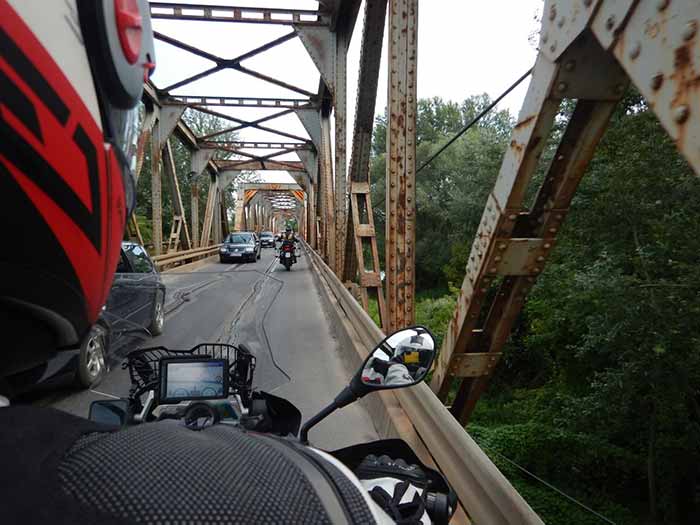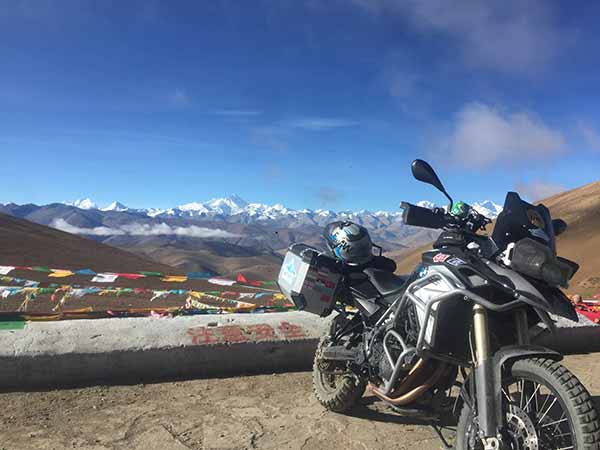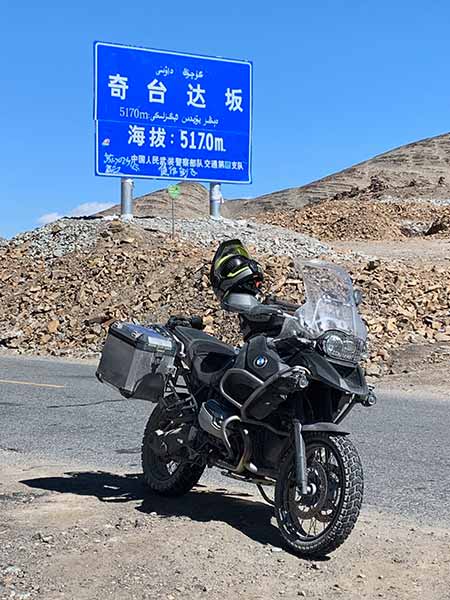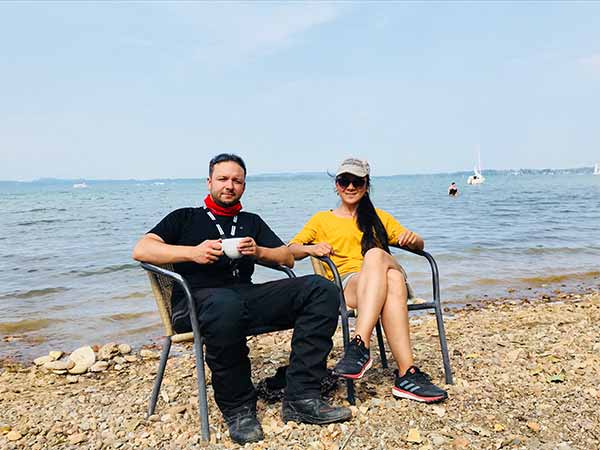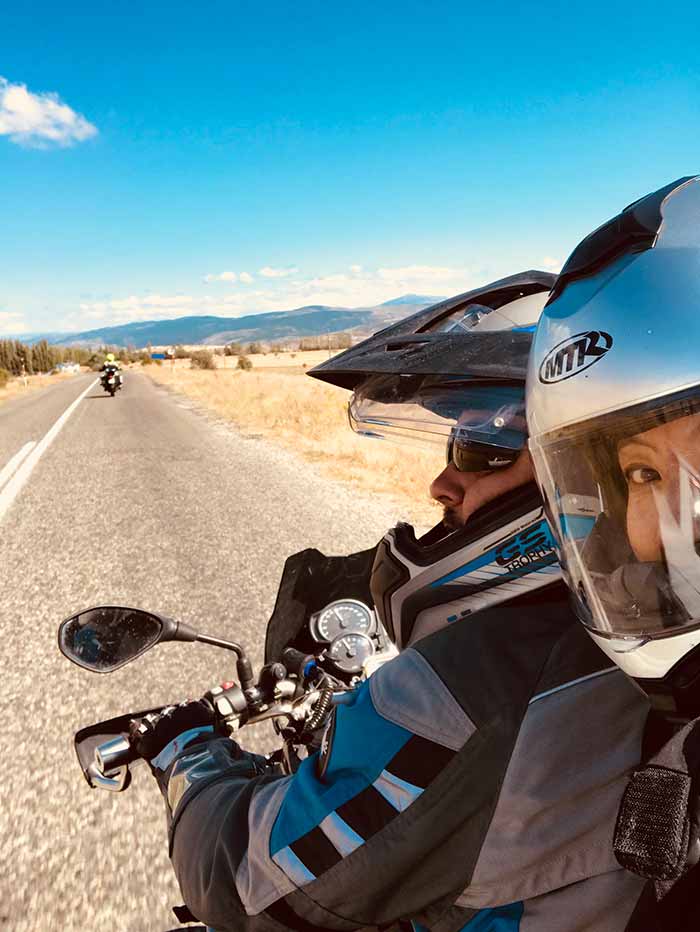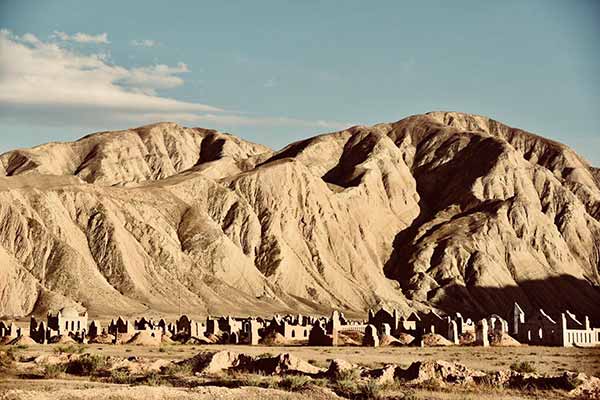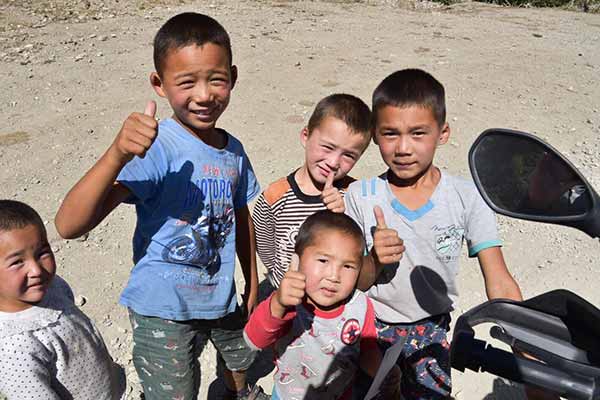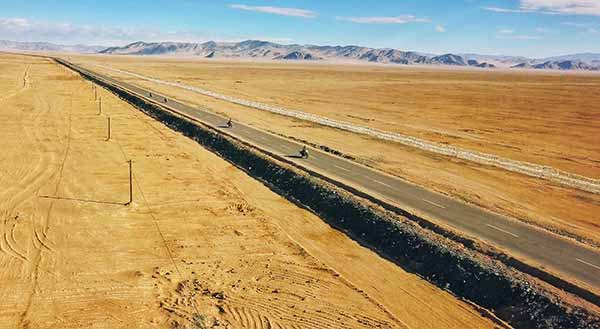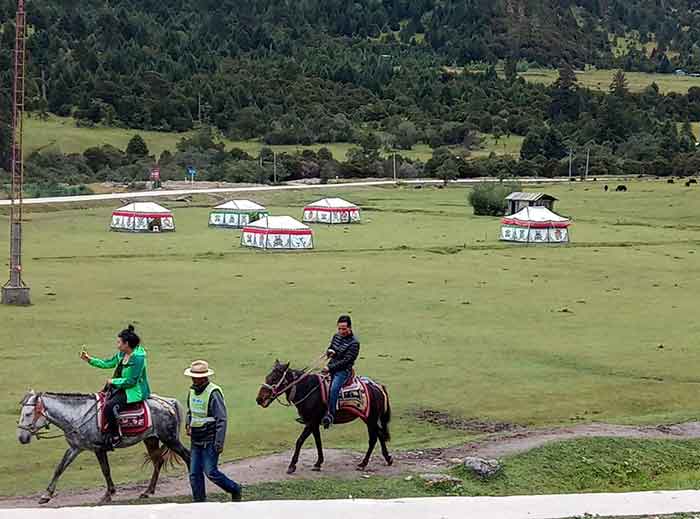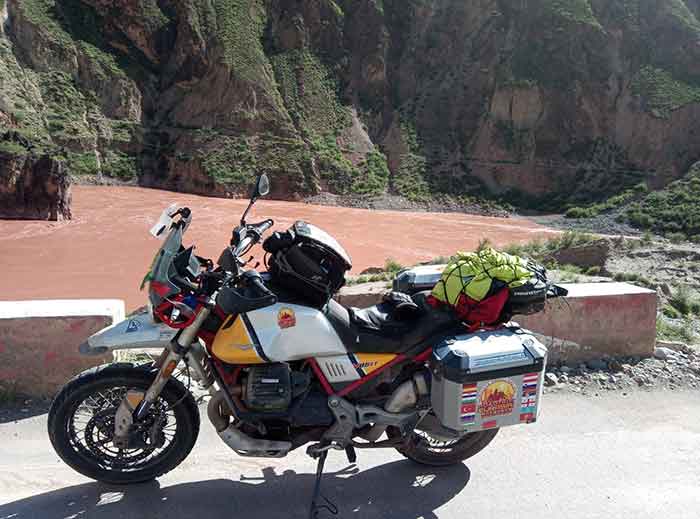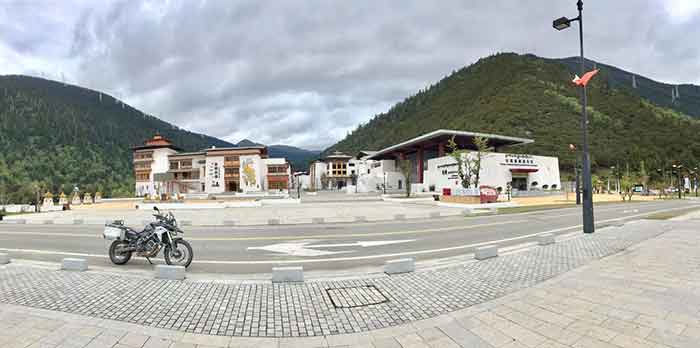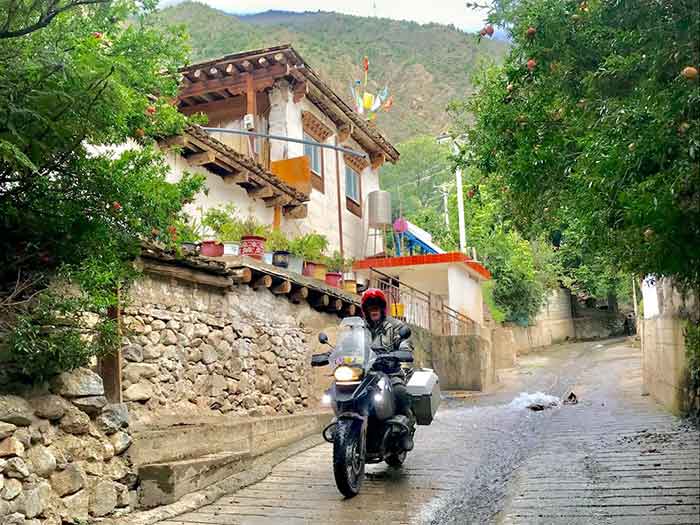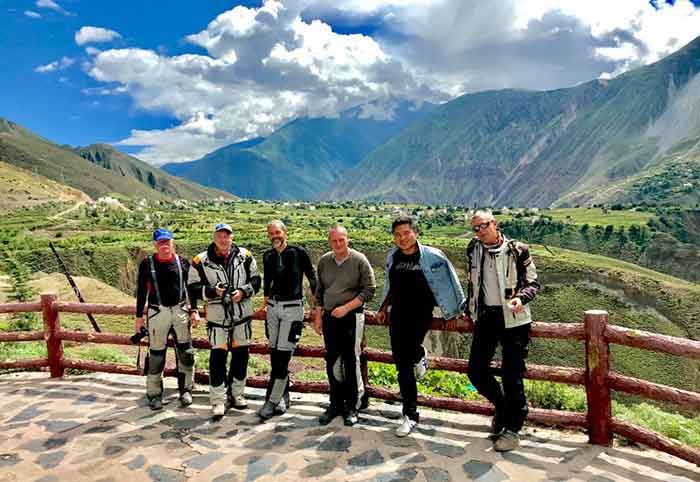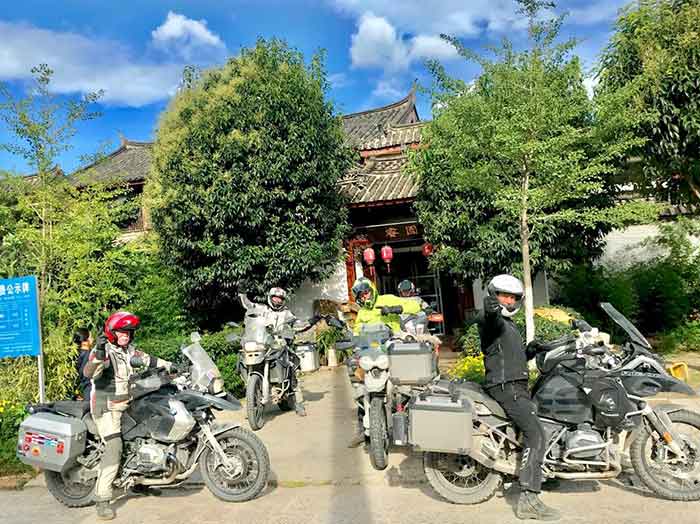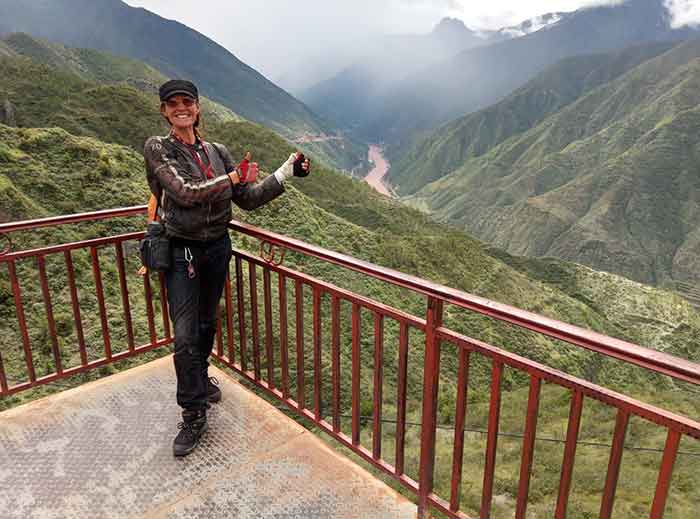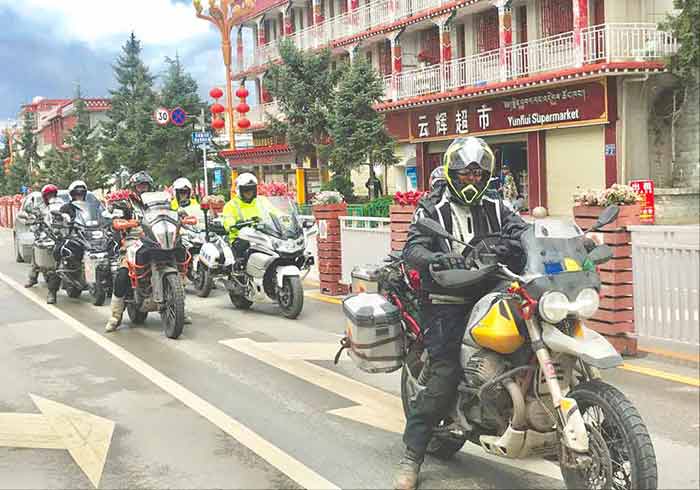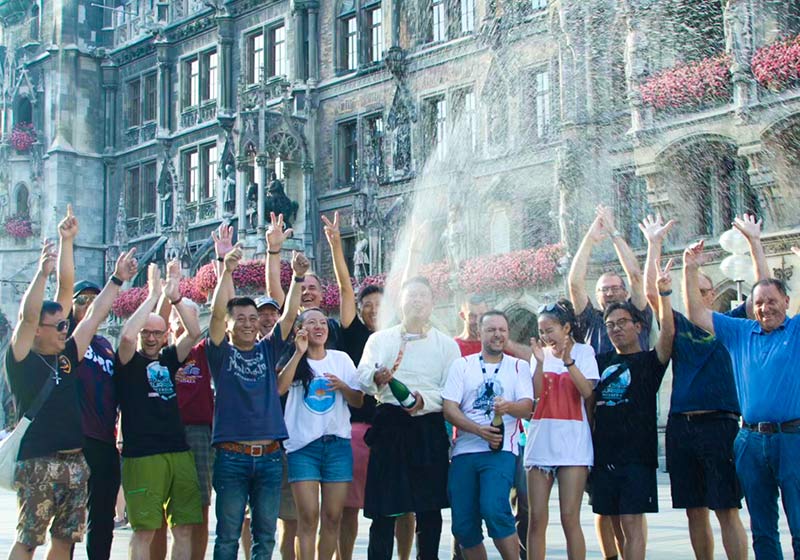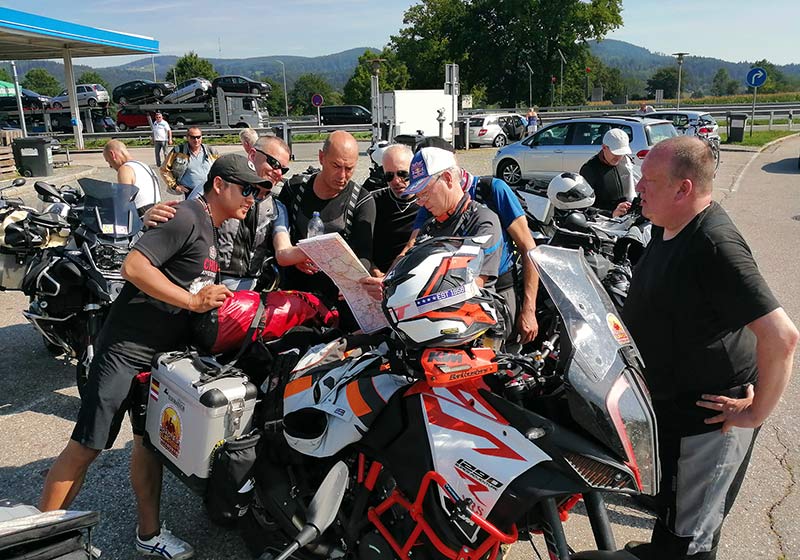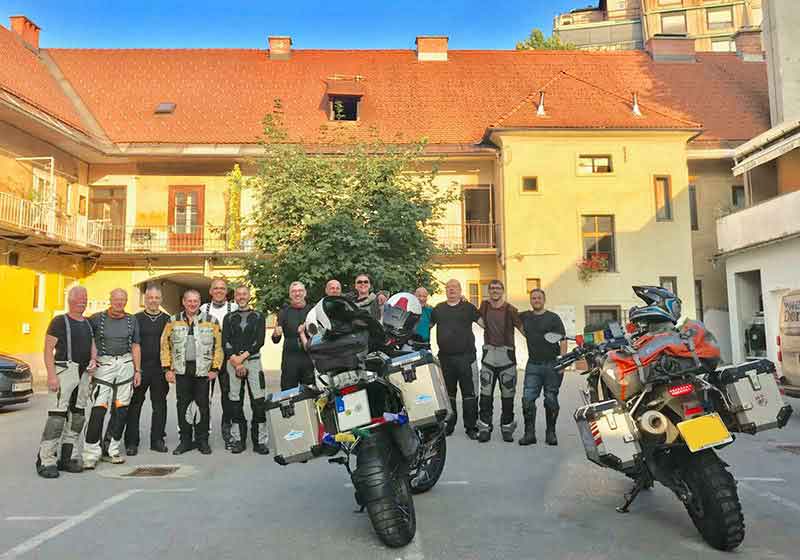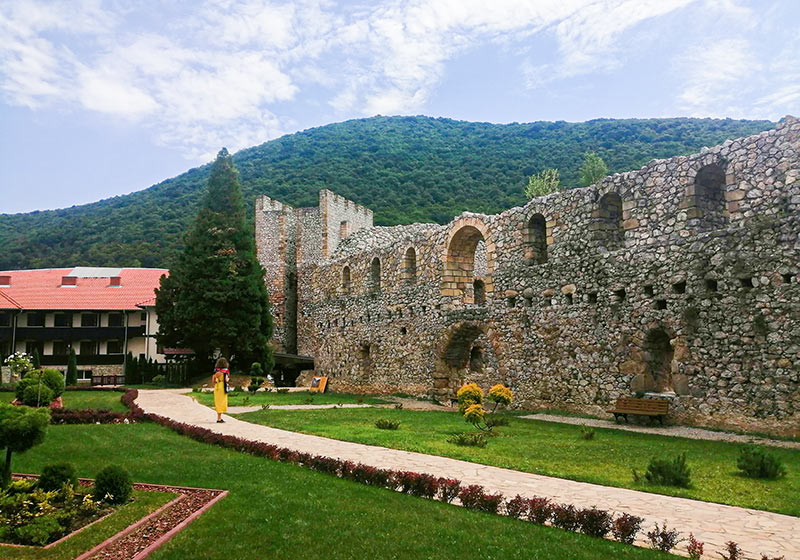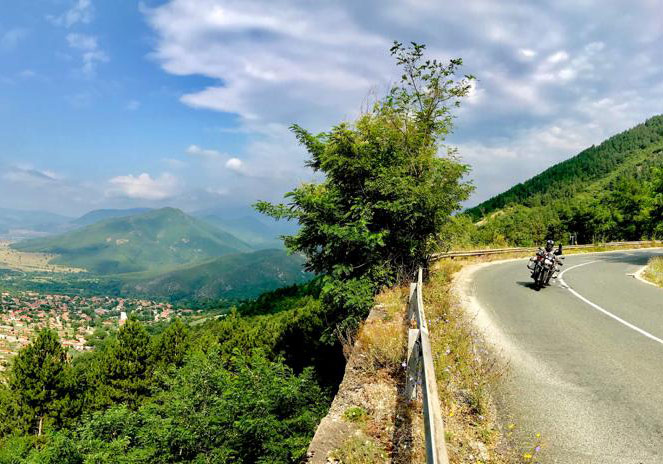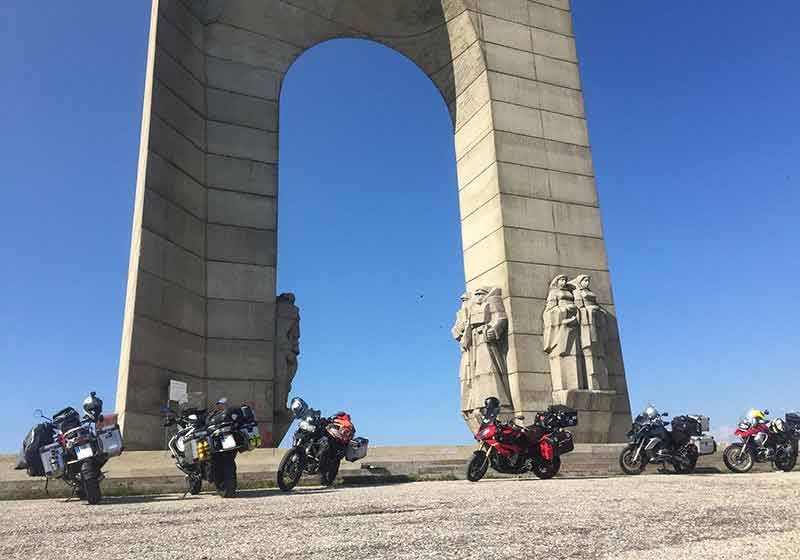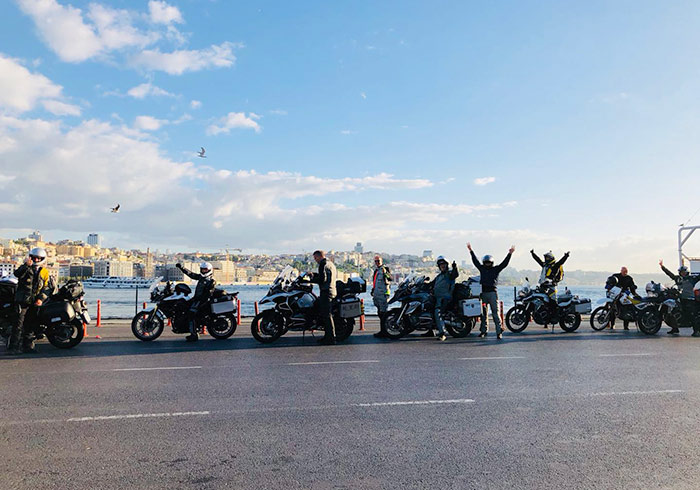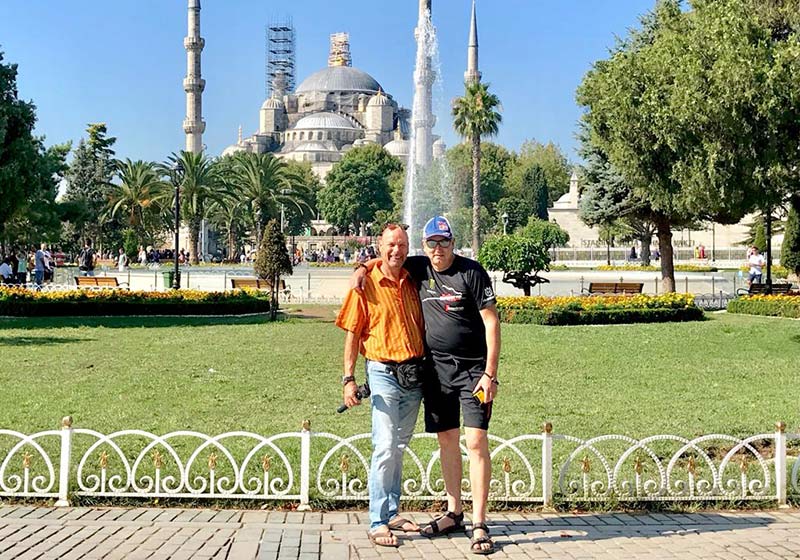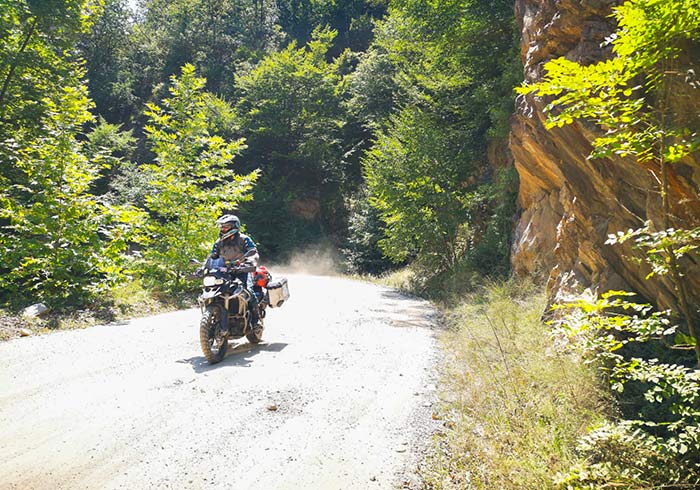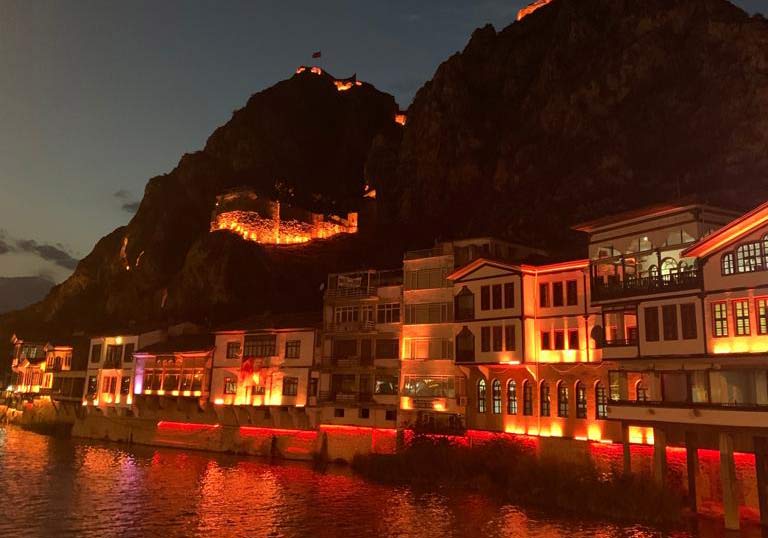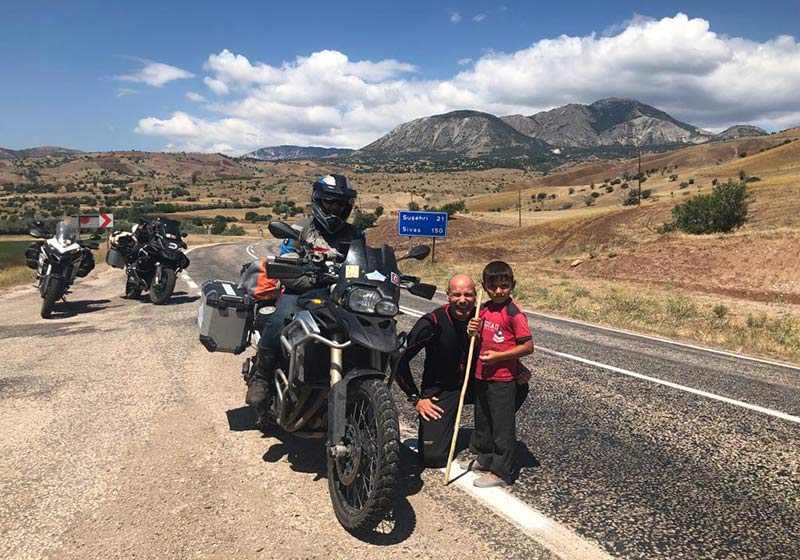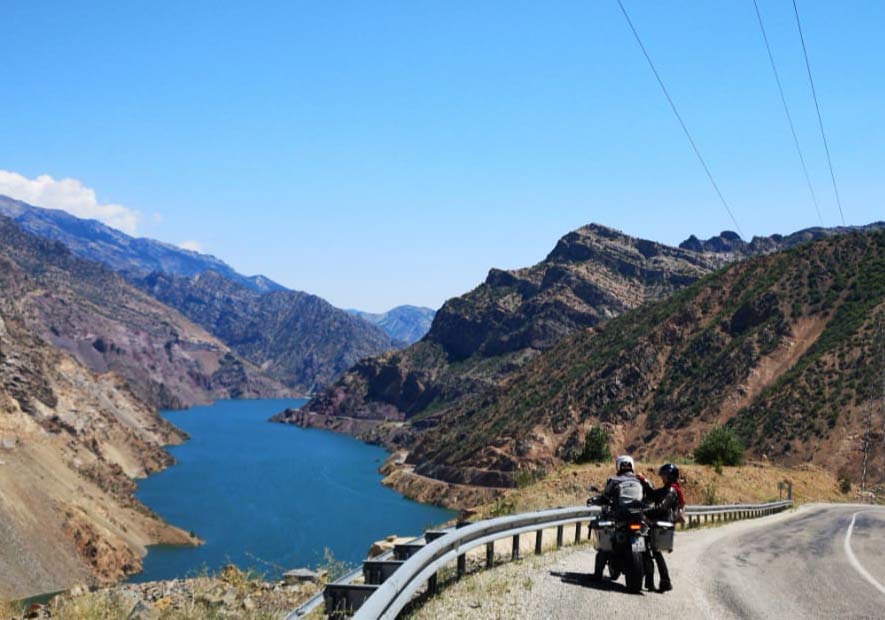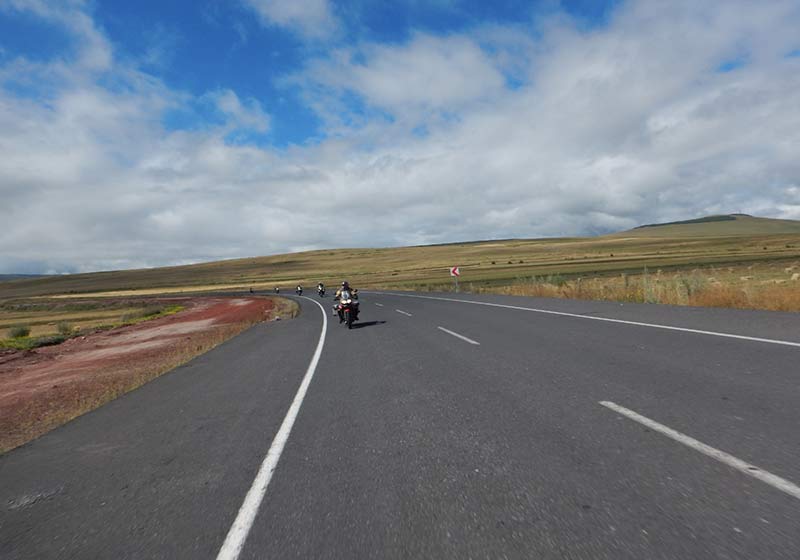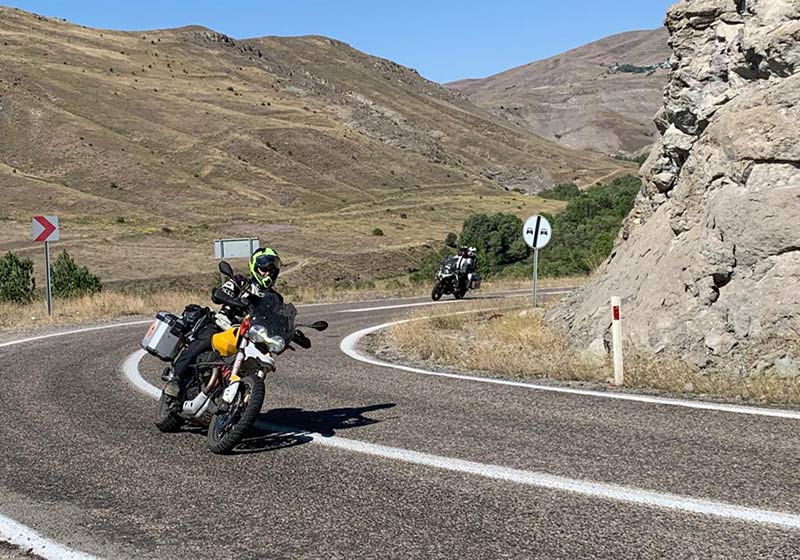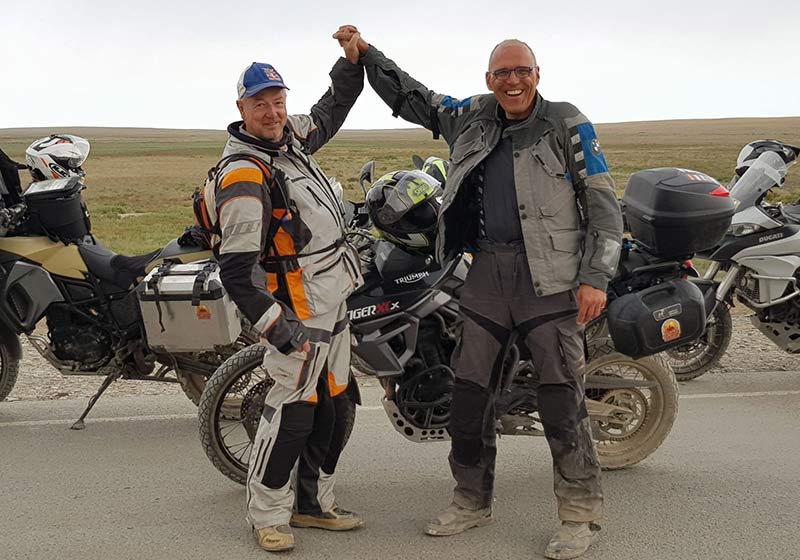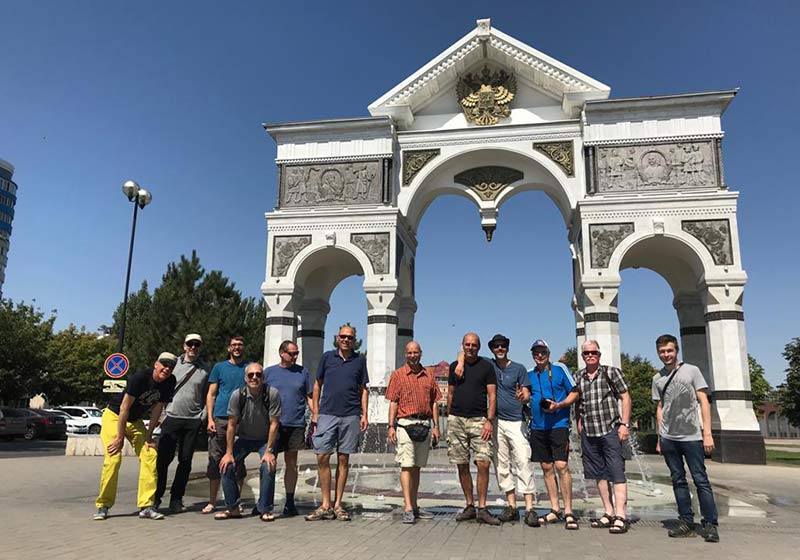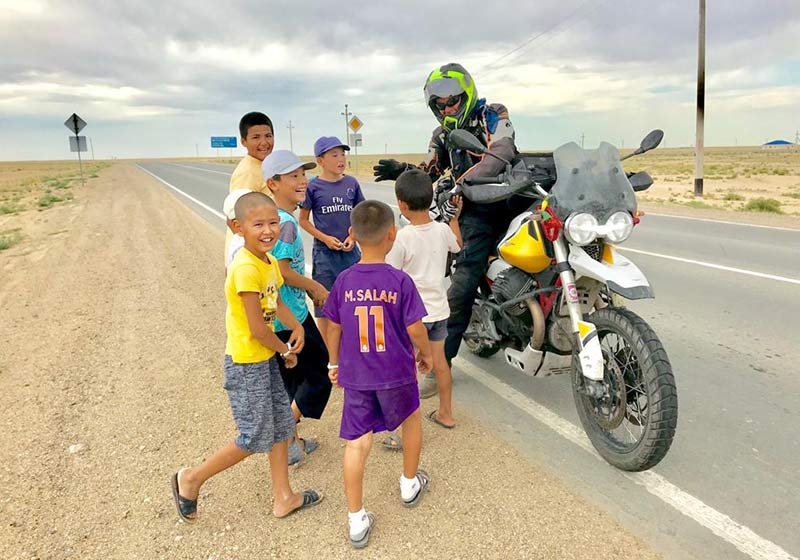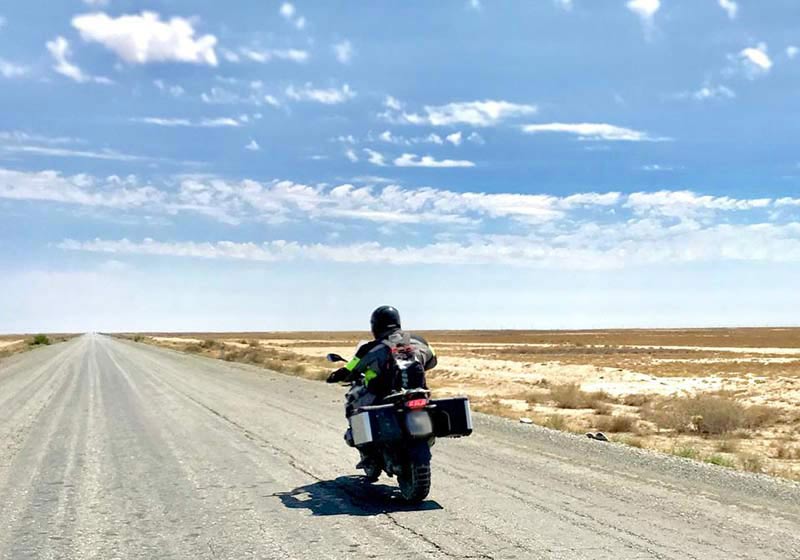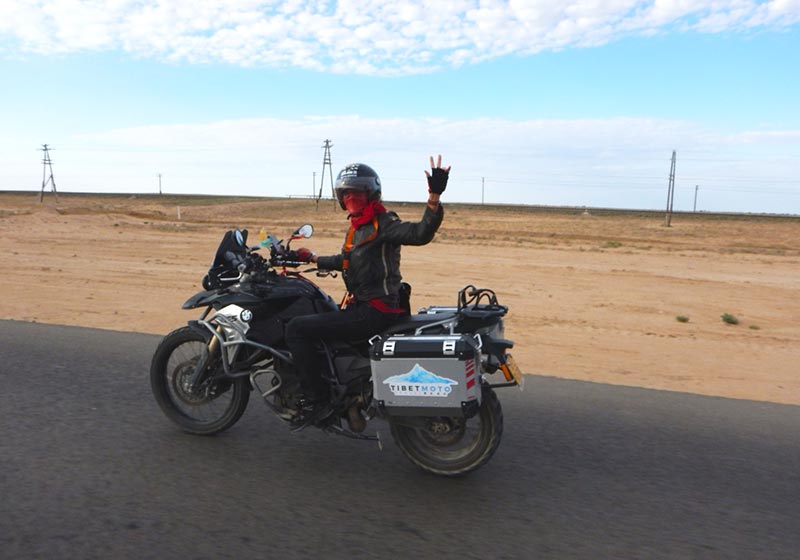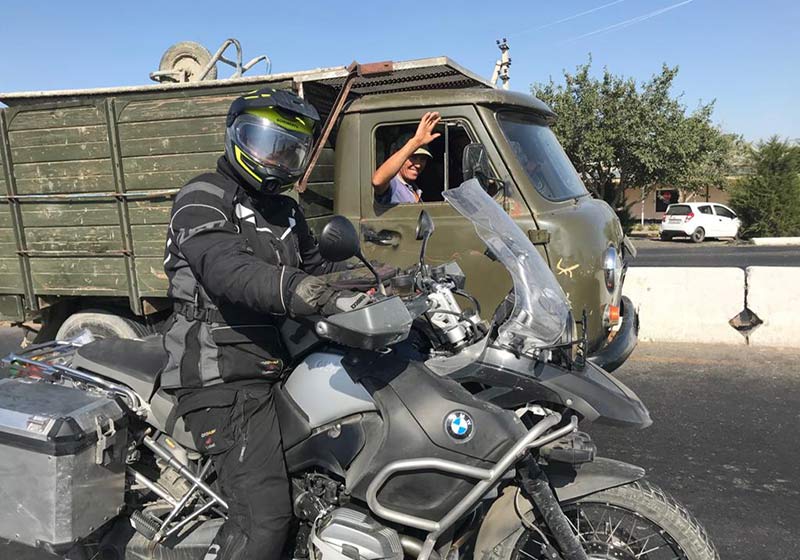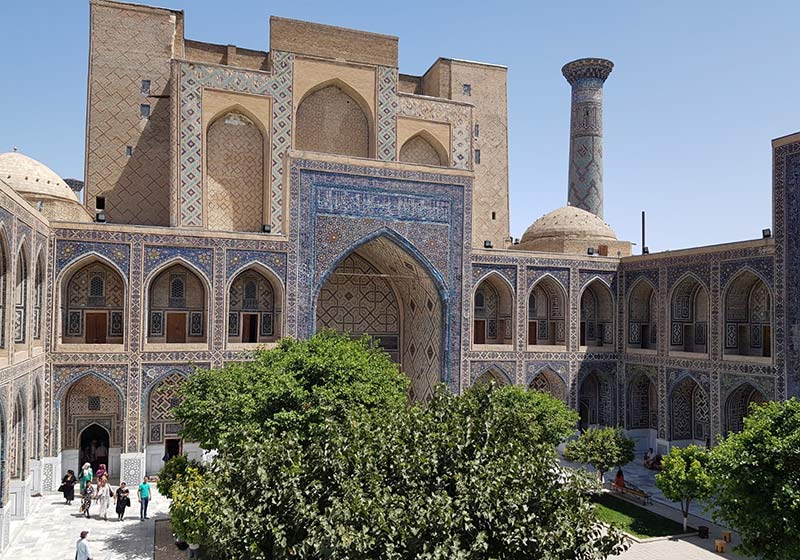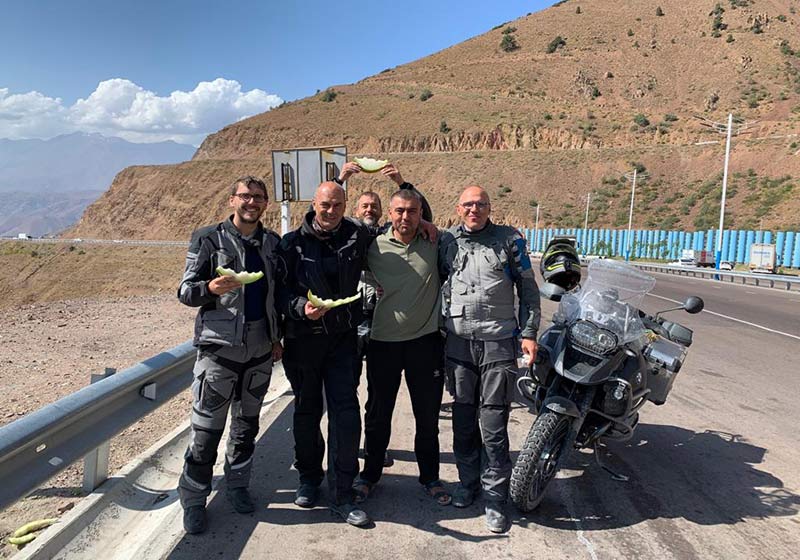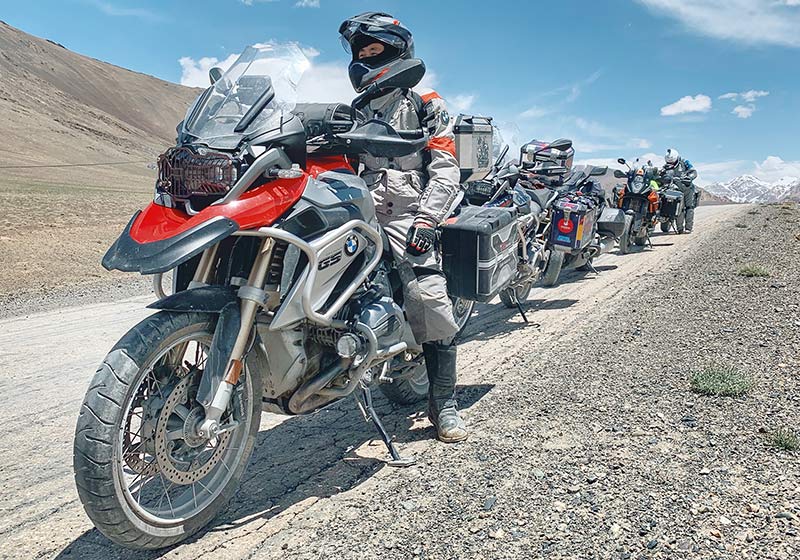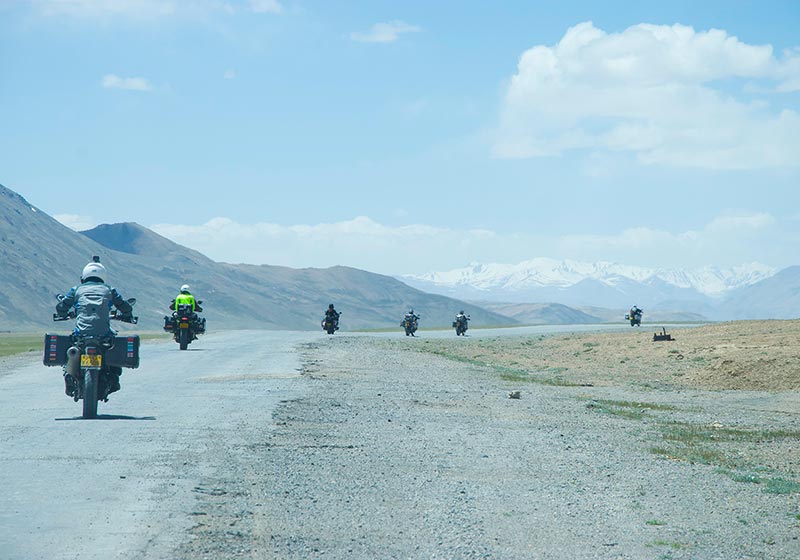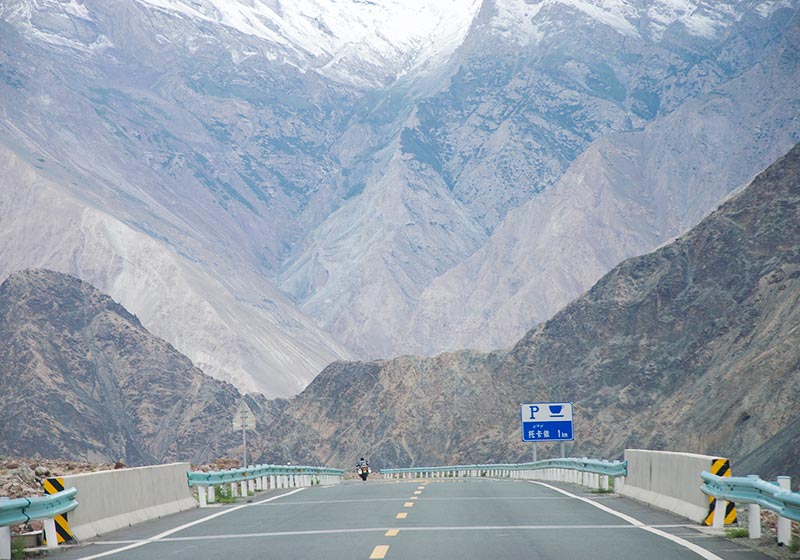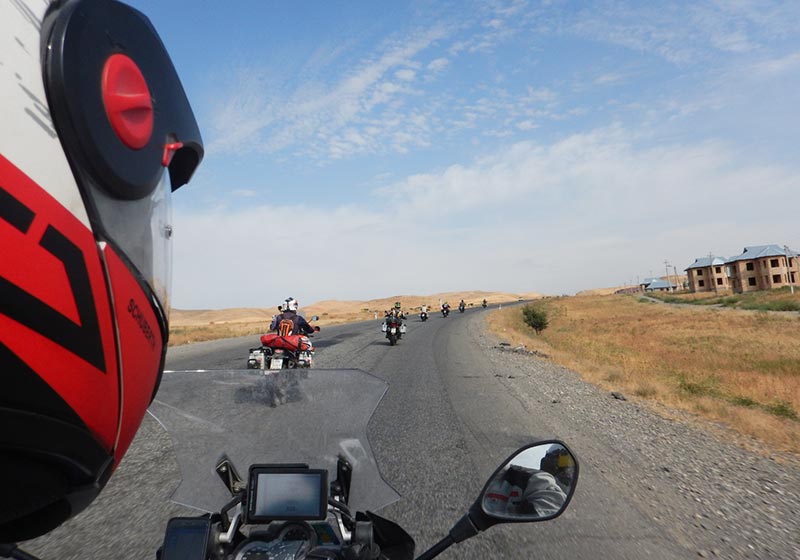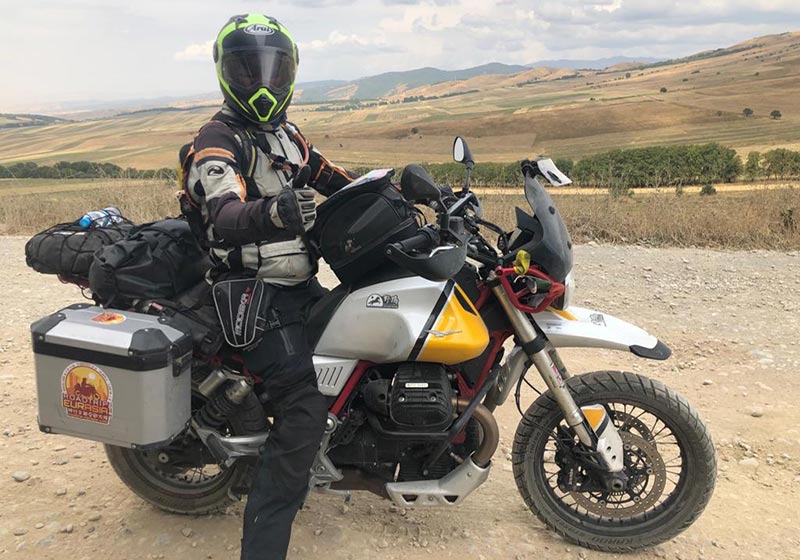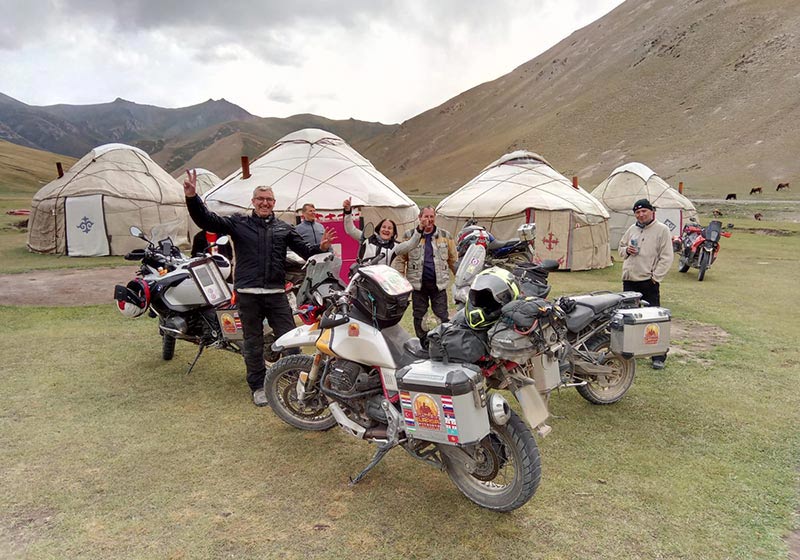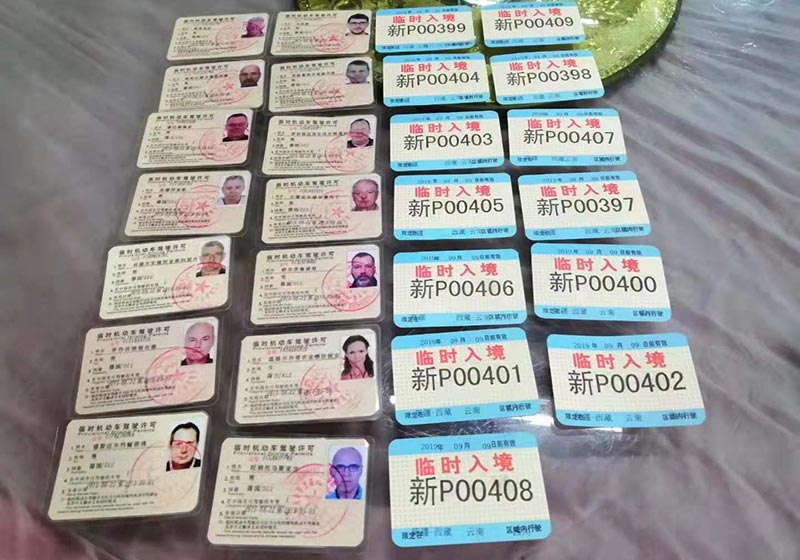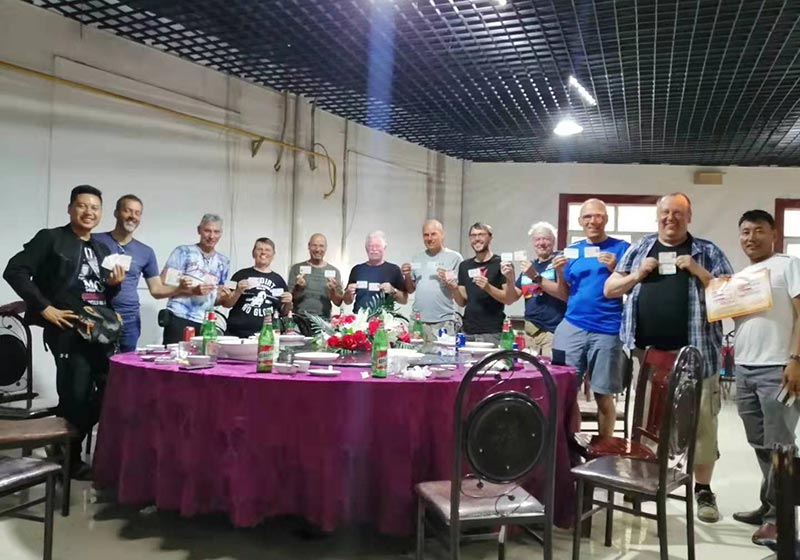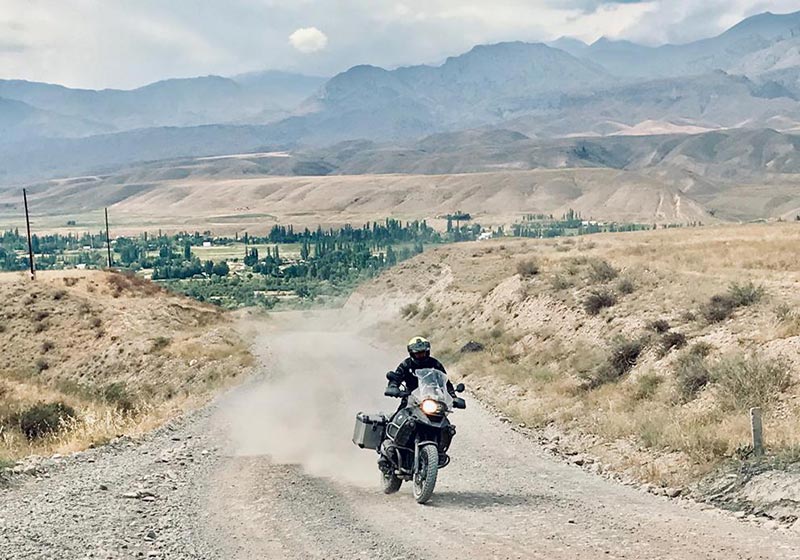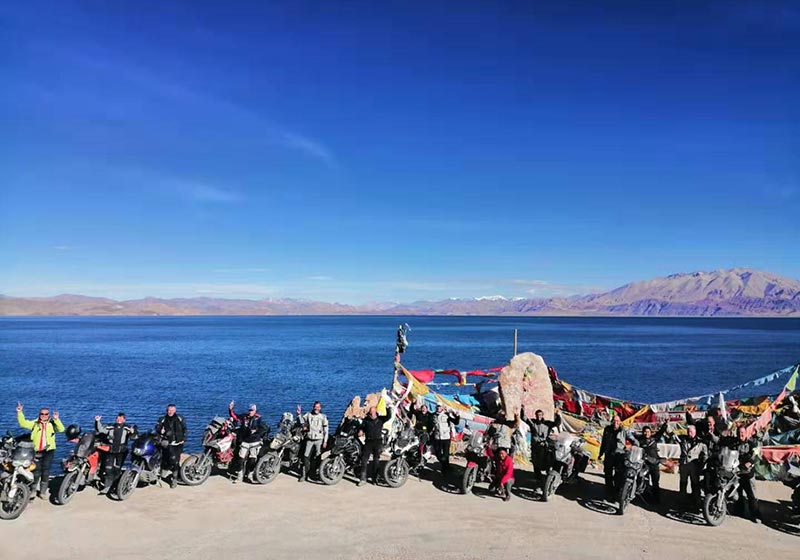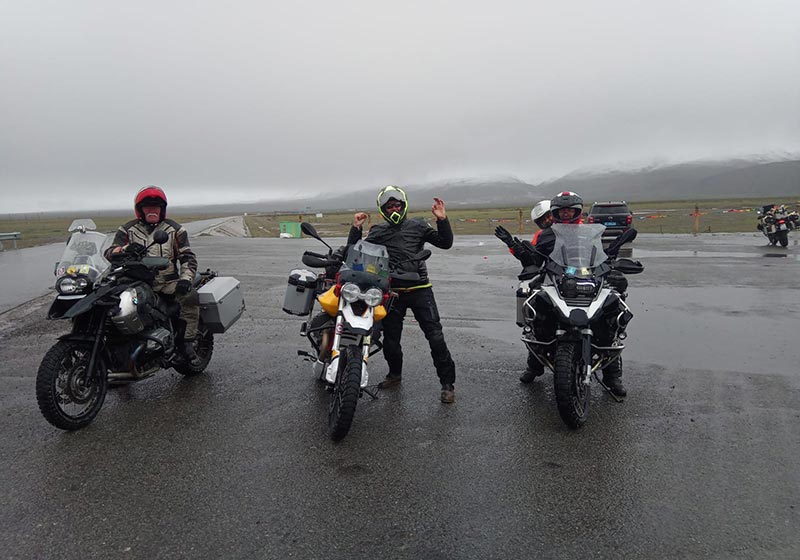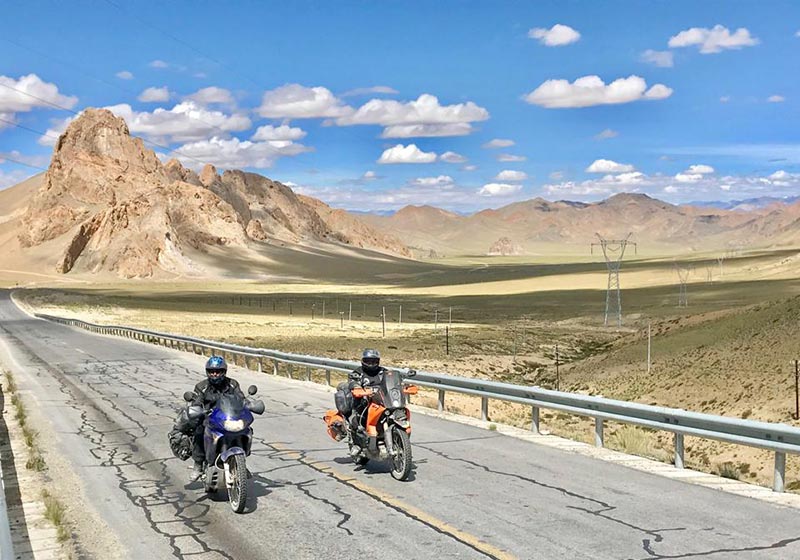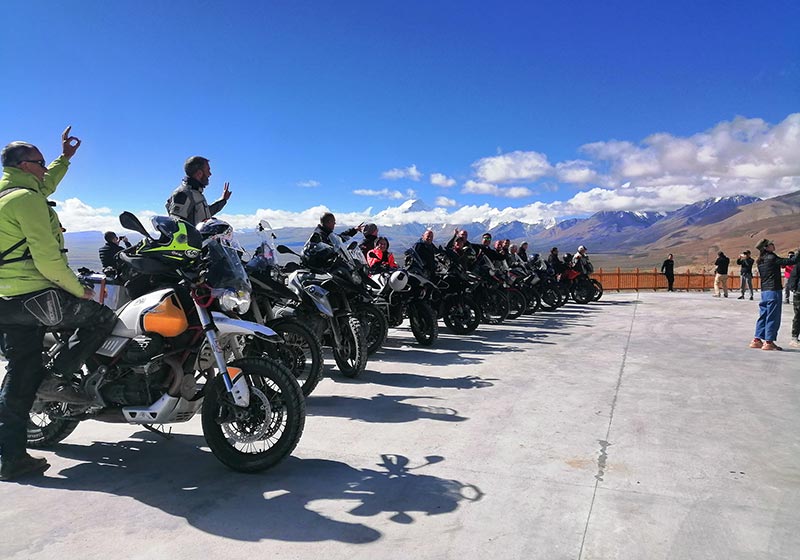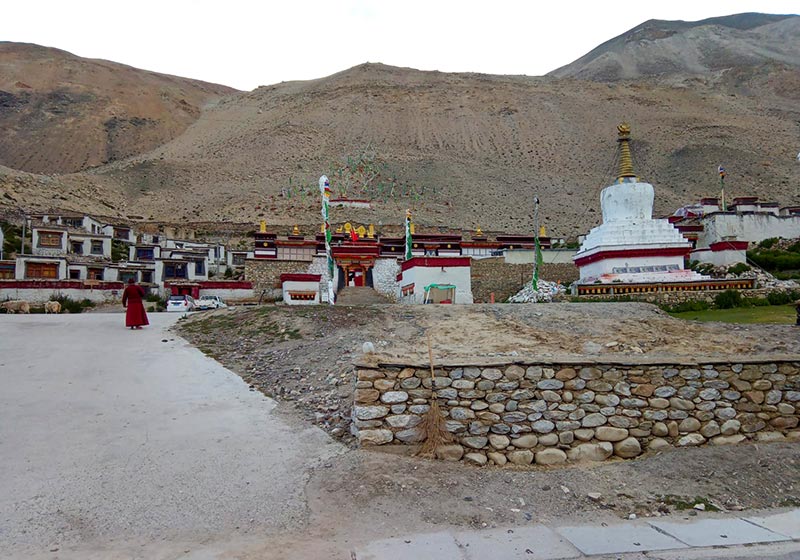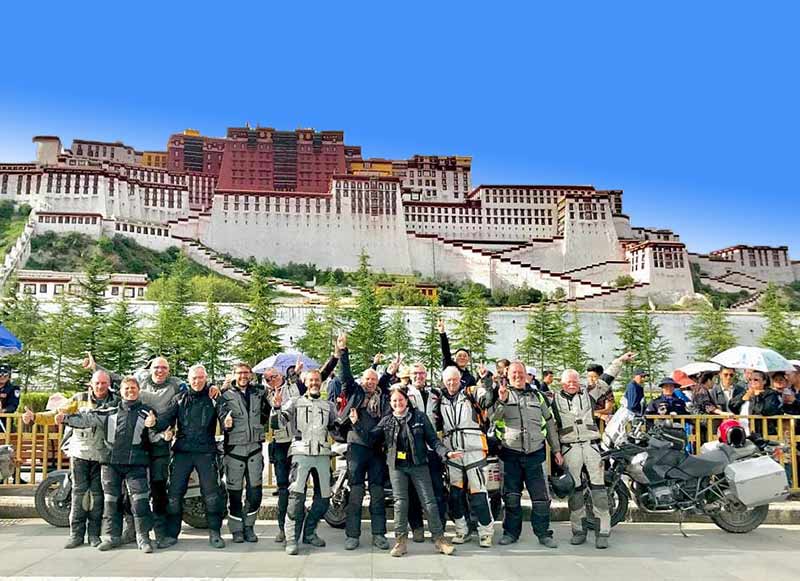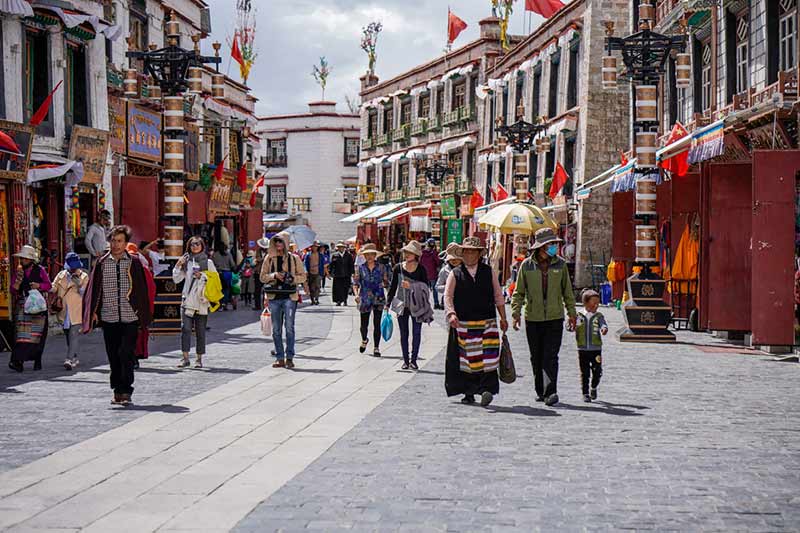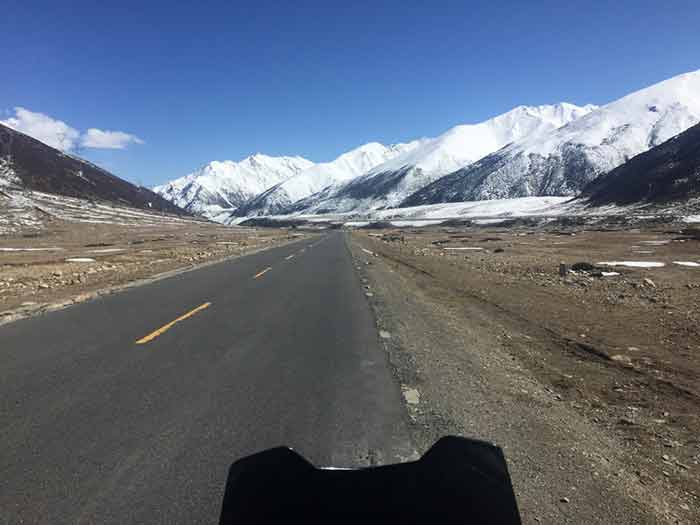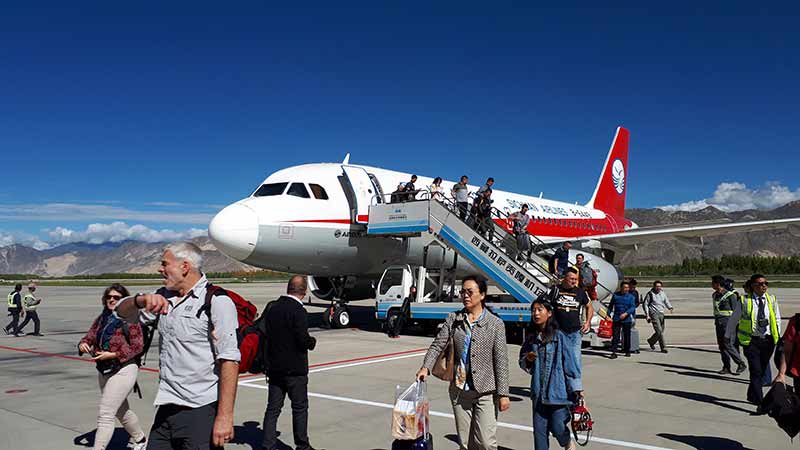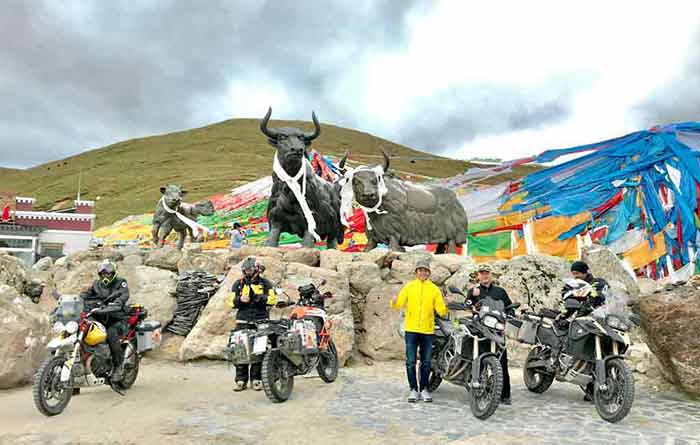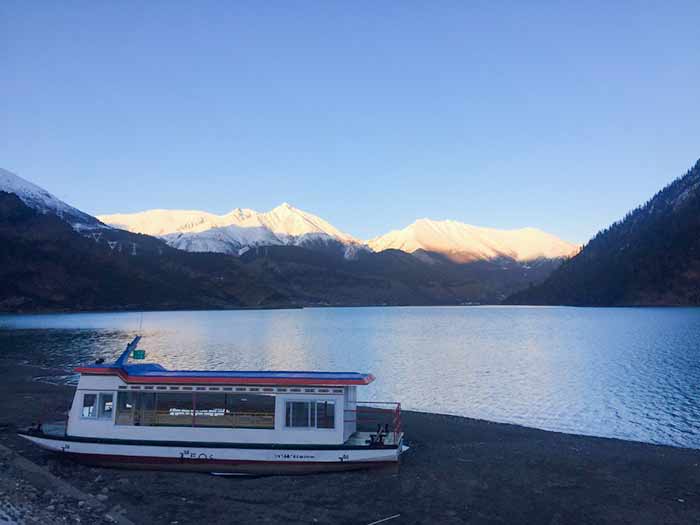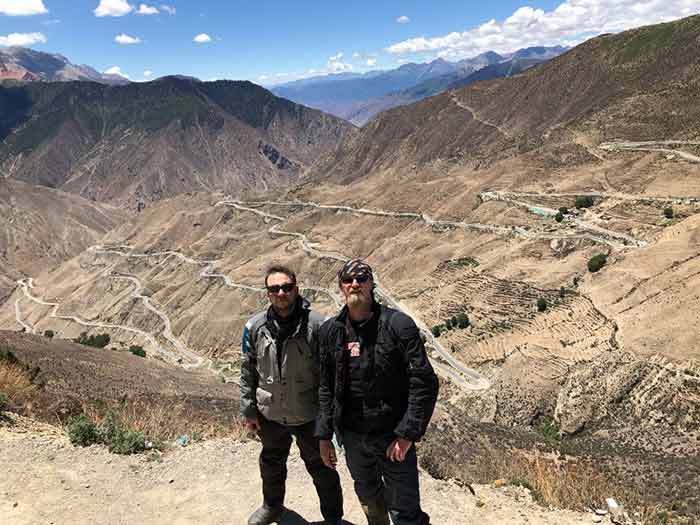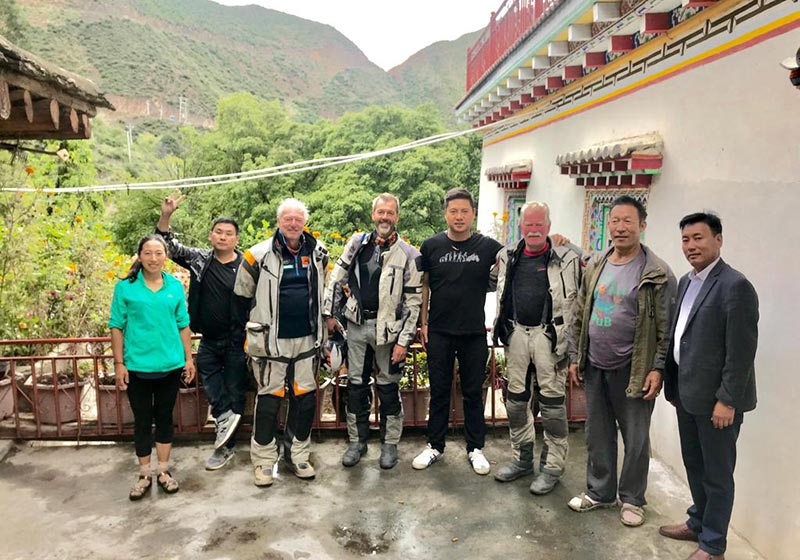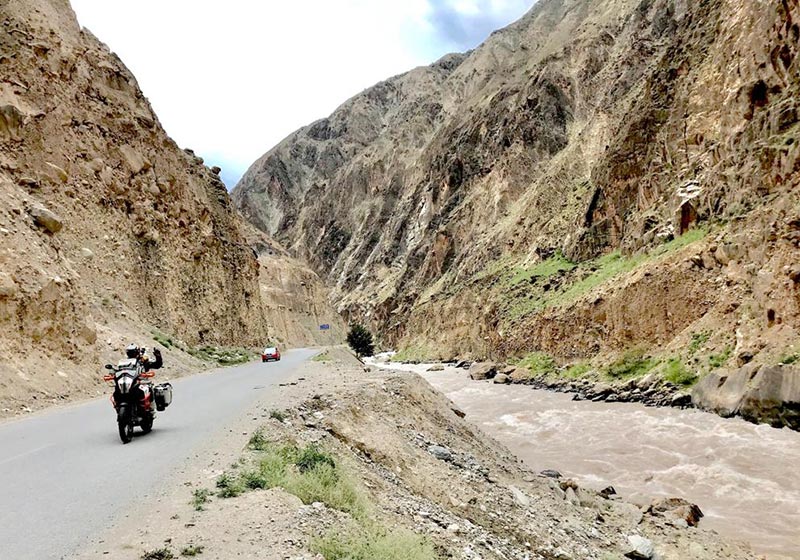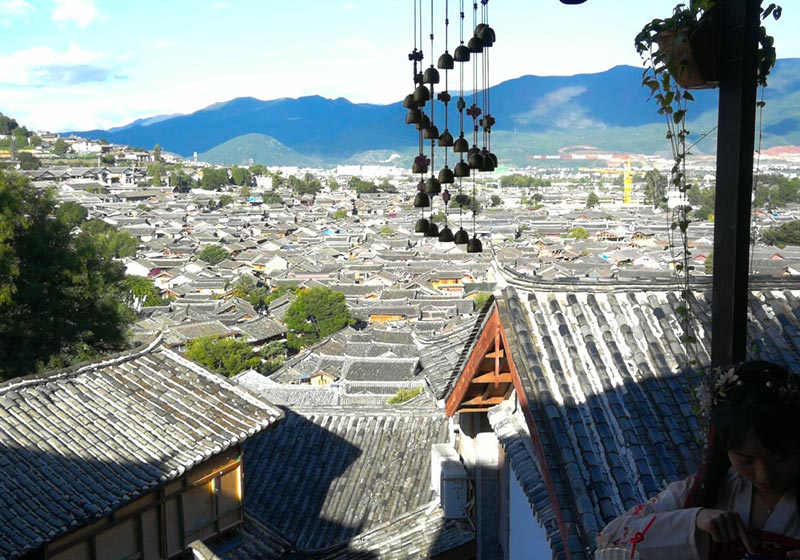

Munich-Tibet Overland Tour
This ultimate motorcycle adventure leads along the Silk Road from Munich to Lhasa, through 14 countries, over 12,500 kilometers, and across the continents of Europe and Asia. EurAsia and the journey along the Silk Road to the Roof of the World in Tibet are both the path and the destination of this spectacular journey, connecting numerous highlights of the historical and modern Silk Road.
The first days take us through lesser-known regions of Eastern Europe, including the romantic capital Ljubljana, the former Soviet backdrop of Belgrade, and the Beklemento Pass deep in the Balkan Mountains of Bulgaria. After reaching the coast of the Black Sea, we enjoy Istanbul, the city that connects the two continents of Europe and Asia. Here, we have a free day and then take the ferry to Asia.
Read more
We climb the Anatolian highlands, follow the Silk Road, and stay in caravanserais and historic UNESCO World Heritage sites before traversing the passes and remote country roads of Georgia. Through Georgia’s forested mountain world, we continue over the Caucasus into the rolling steppes of Russia. A vast horizon opens up: the shores of the Caspian Sea. Here, we pass through the grass steppes with camel herds and discover the unknown southern Russia, inhabited by a Mongolian steppe people who settled here hundreds of years ago.
We continue to follow the Silk Road through Central Asia’s largest desert to Khiva, Bukhara, and Samarkand in Uzbekistan – the pearls of the oriental Silk Road with their numerous cultural and historical attractions. From Samarkand, our Silk Road motorcycle tour continues to Tajikistan, where we reach the capital Dushanbe – the gateway to the famous Pamir Mountains. Over the spectacular Pamir Highway, the mother of all adventure trails in Central Asia, with its high passes and sparsely populated mountains, we proceed to Kyrgyzstan. Beautiful Kyrgyz trails make each day a highlight; we stay in homestays with friendly locals and in yurt camps – remnants of the historic caravanserais of the Silk Road.
Over the breathtaking nearly 4,000-meter-high Torugart Pass, we approach our destination: Tibet. A long day’s ride along the Taklamakan, the “Desert of No Return,” brings us to the foothills of the Kunlun Mountain range before we ascend to the Tibetan Plateau: 5,000-meter-high passes need to be crossed.
We travel across the Roof of the World from west to east, pausing at the holy Mount Kailash for Buddhists and Hindus, which is beneficial for our karma, and hike a part of the way with Tibetan pilgrims. The seemingly endless shores of Lake Manasarovar, not far from Kailash, with its monasteries, nomads, and hermitages, bring us closer to Tibetan culture and religion. Then we reach the Rongbuk Monastery at the world’s highest mountain, Everest. At 5,200 meters, we enjoy one of the most spectacular views on Earth, looking at Everest and the curviest roads and passes in all of Asia stretching out before us. Along turquoise salt lakes, glaciers, and historical monasteries and Tibetan cultural sites, we reach mystical Lhasa, where the main part of the journey ends. Here, we wander with hundreds of Tibetan pilgrims through the old town at Barkhor Market and visit the former seat of the Dalai Lama, the iconic and world-famous Potala Palace.
On the optional extension through the Eastern Himalayas and eastern Tibet, we head into the subtropical province of Yunnan, which translates to “South of the Clouds.” The mighty rivers Yangtze, Mekong, and Salween await us with winding routes and spectacular gorge landscapes.
This route was closed to foreigners for many years and offers entirely new Himalayan landscapes, historical sites of Chinese culture, and curvy riding fun from the heights of the Himalayas down to China’s tea-growing areas and fertile valleys. The journey takes us through the Tiger Leaping Gorge, one of the deepest gorges in the world, and ends in Dali after visiting the UNESCO World Heritage city of Lijiang.
From either Lhasa or Dali, we return home. Our local team takes care of shipping the motorcycles back. The tour is jointly organized by Classic Bike Adventure and Tibetmoto, the Tibet expert.
AT A GLANCE
 |
Main Tour: 24.04. – 10.06.2025 Extension: 09.06. – 16.06.2025 Main Tour: 05.06. – 22.07.2025 |
||||||||||||
 |
|
||||||||||||
 |
48 days / 47 nights / 39 riding days With extension: |
||||||||||||
 |
Overnight stays in hotels of the middle class and in guesthouses |
Highlights – Munich-Lhasa Overland Motorcycle Tour
- 14 Countries and Over 12,500 Kilometers: An adventure of a lifetime, covering all the highlights of the Silk Road up to Tibet, the Roof of the World.
- Central Balkan Mountains: Experience the Beklemento Pass.
- Istanbul & Anatolian Highlands: Visit the Silk Road towns of Safranbolu and Amasya.
- Highlands of Georgia: Explore the steppes of Russia and Kazakhstan.
- Crossing the Largest Desert in Central Asia: Journey through vast desert landscapes.
- Time for All Attractions: Sufficient time to explore the Silk Road oases of Samarkand, Khiva, Bukhara, and Dushanbe.
- Tajikistan and the World-Famous Pamir Highway: Ride through stunning high mountain passes.
- Kyrgyzstan’s Beautiful Trails and Caravanserais: Discover the charm of Kyrgyzstan’s historic routes.
- Tibet from West to East: Including all highlights of the Tibetan Himalayas, such as Lake Manasarovar, the sacred Mount Kailash, Everest Base Camp, Yamdrok Lake, Xigaze, and Lhasa.
- Everest Base Camp: Spectacular views of Everest from an altitude of 4,900 meters.
- One of the World’s Most Spectacular Roads: Experience breathtaking views of the highest mountains on Earth from the Everest Base Camp.
- Full Days in Istanbul, Samarkand, and Lhas: Enjoy city tours and cultural explorations.
- Regular Rest Days: For relaxation and sightseeing.
- Proven and Current Route Guidance: Our team has successfully conducted this tour many times.
- Support Vehicle: For passengers and luggage, as well as emergency assistance.
- Mechanic Service: Available throughout the journey.
- Return Shipping of Motorcycles Included: No extra costs for shipping your bike back home.
- Local Guides in Many Countries: Providing the best insights into local cultures.
- Optional extension from Dali to Lhasa
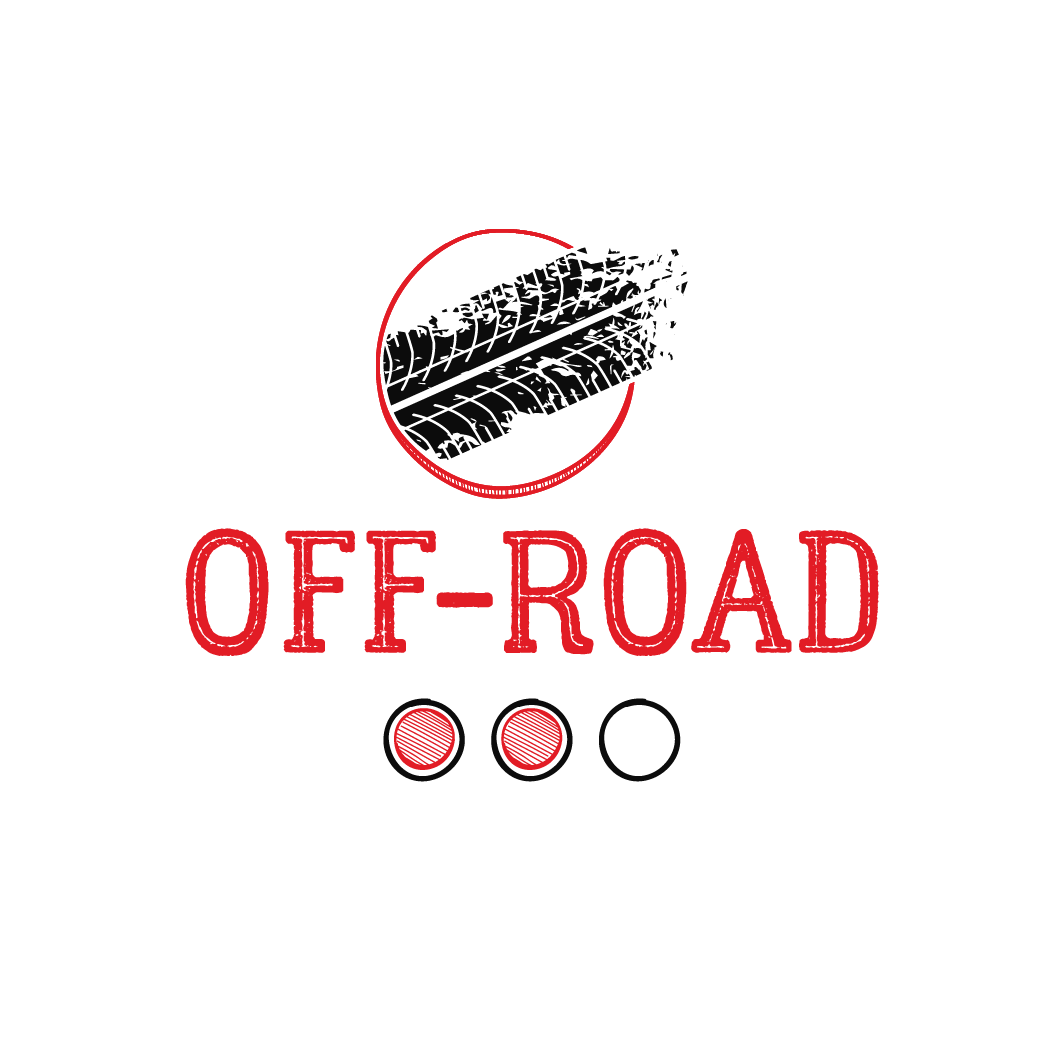


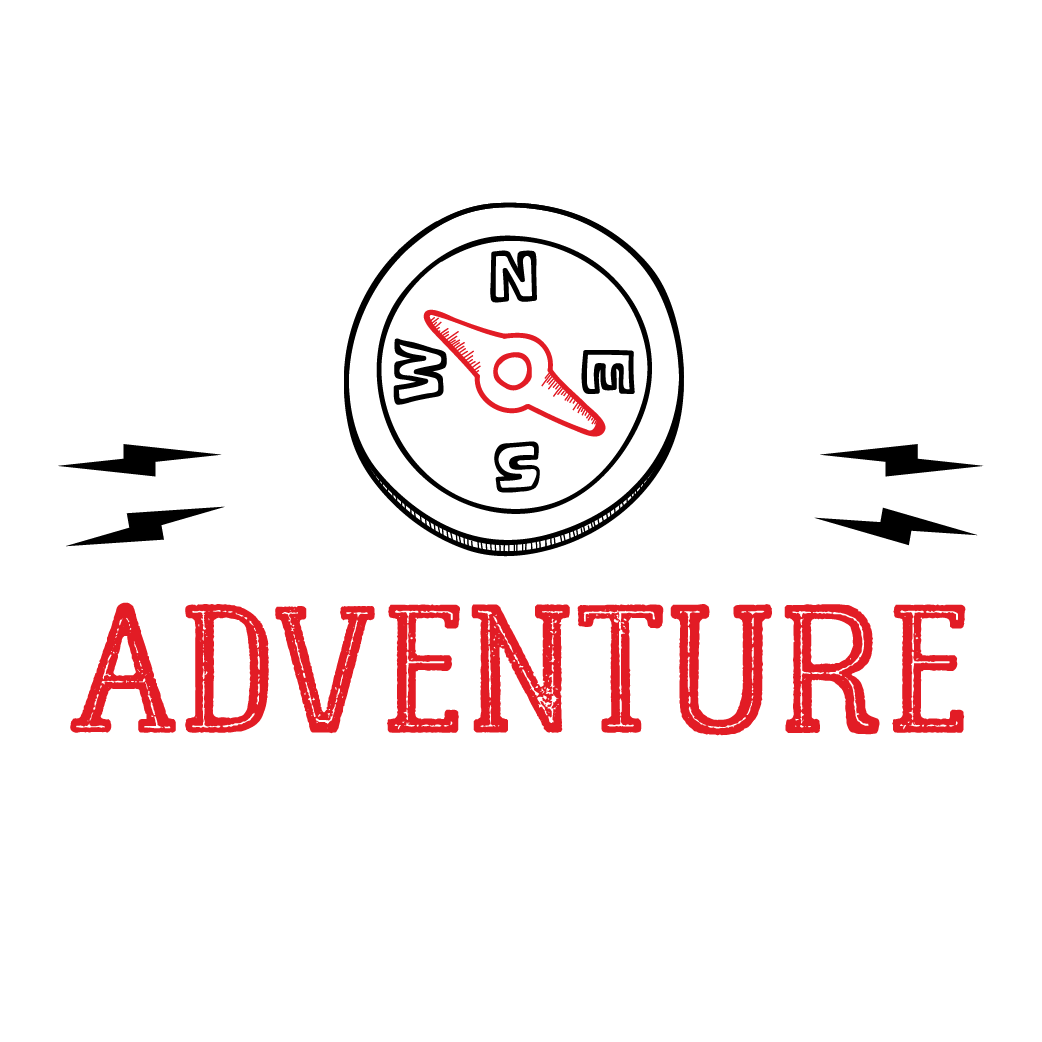
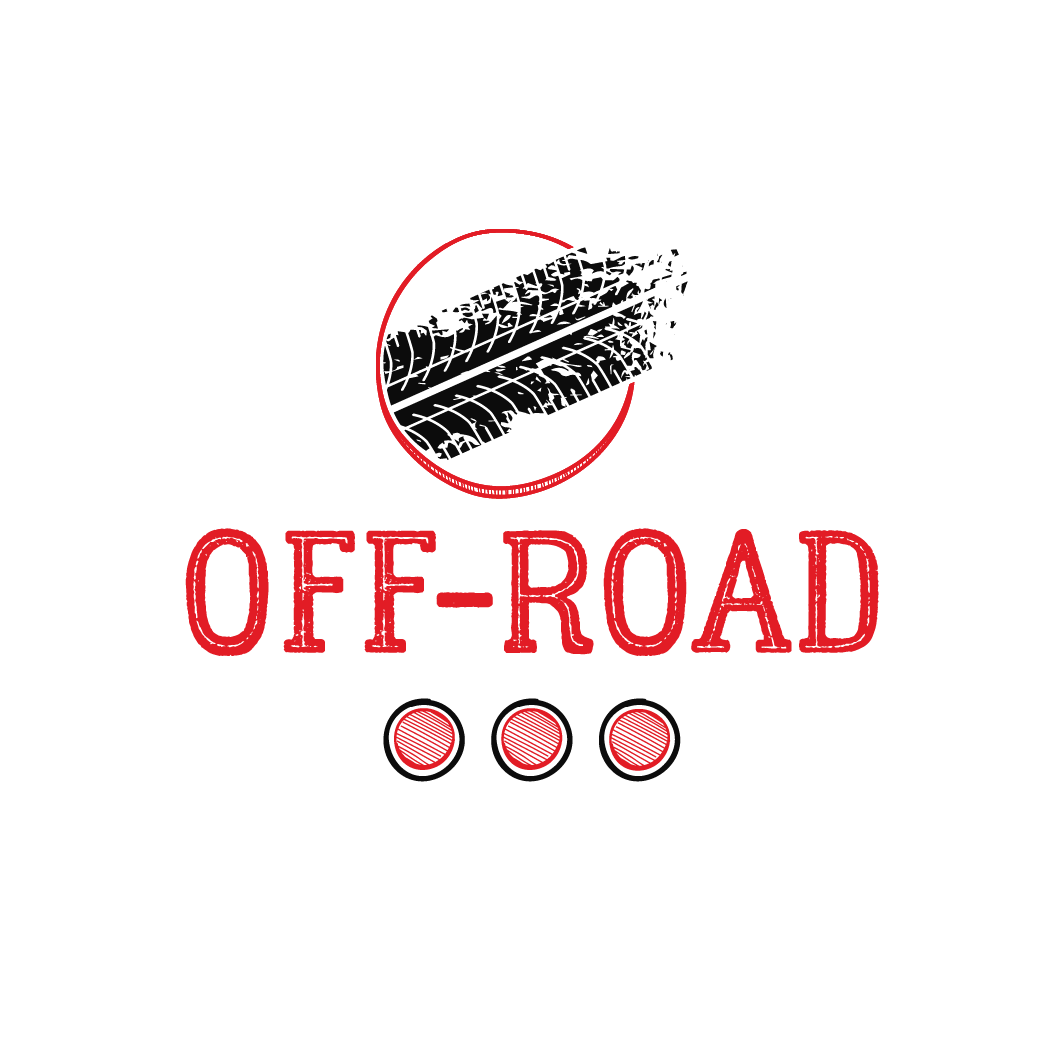
Parts of the route – up to entire day’s rides – are unpaved. In addition to good natural tracks, there are also tracks that were once paved and where the asphalt has crumbled. These are marked by potholes and bumps. Longer passages can be covered with sand or pebbles. The unpaved/paved ratio is around 40/60.
These routes feature the most challenging, winding mountain roads with a variety of surfaces. Narrow, often single-track roads with hairpin bends offer challenges for experienced riders. Focus and stamina are essential.
Visiting a place of interest every few days
With short breaks and photo stops, not counting breaks for lunch, which last about an hour. Average figures: 6-8 hours per day
Von München nach Tibet – Tourbeschreibung
Day 1: Meeting in Munich
Meeting of tour participants near Munich. Detailed tour briefing in the afternoon. Get to know each other over dinner in Munich.
Day 2: Munich – Ljubljana
From Munich, we traverse the eastern Alps and find ourselves in the small, beautiful capital of Slovenia. The old town, built right along the Sava River, exudes charm, making it a perfect place for a relaxed start to our journey. We enjoy a stroll through the old town and have dinner at the foot of Ljubljana Castle.
Distance covered: approx. 400 km, Slovenia
Day 3: Ljubljana – Belgrade
We traverse the rugged and arid Croatian hinterland and reach Serbia, the first country outside the EU on our journey. Belgrade is a remarkable city that has reestablished itself in Europe following Soviet occupation. Architecture enthusiasts will find much to admire here, as few places showcase Soviet grandeur alongside buildings from various other eras. The city is situated at the confluence of the Sava and Danube rivers, with the Belgrade Fortress overlooking the beautiful old town.
Distance covered: approx. 530 km, Croatia – Serbia
Day 4: Belgrade – Nis
A relaxed day awaits us! From Belgrade, we continue to Nis, where we can explore the old town.
Distance covered: approx. 240 km
Day 5: Nis – Koprivshtitsa
In Serbia and Bulgaria, we find ourselves in the heart of the Balkans. The vastness of the landscape that unfolds before us is unlike anything found in Central Europe. Rural and wild, Eastern Europe presents itself as a reminder of a long-forgotten Europe. Appropriately, we stay overnight in the small, authentic town of Koprivshtitsa, which captivates with its rustic-style houses and relaxed way of life.
Distance covered: approx. 270 km, Bulgaria
Day 6: Koprivshtitsa – central Balkan Mountains – Sozopol
Today, we explore the central Balkan Mountains, which gave the entire region its name. Rising over a thousand meters above Bulgaria, we have an incredible view of the vast landscape from the Beklemento Pass (1,520 m). Beautiful curves lead us back down as we continue our journey through the Bulgarian hinterland, heading east to the Black Sea and the town of Sozopol. The region around Sozopol originated from the Greek colony of Apollonia and is one of the oldest cities in Bulgaria, with a history spanning over 3,500 years. We spend the rest of the day relaxing on the beach or exploring the peninsula of Sozopol.
Distance covered: approx. 410 km
Day 7: Sozopol – Istanbul
We follow the coast southward and then traverse the Strandzha Mountains of Thrace. Curvy roads wind through this forested mountain range until we reach the Turkish border. After the mountains, the dry steppe of Thrace begins, and soon we arrive in Istanbul. Our fantastic hotel is located right in the historic old town, with all major attractions, such as the Hagia Sophia, within walking distance.
Distance covered: approx. 320 km, Turkey
Day 8: Istanbul
A day to explore Istanbul begins with a three-hour guided tour in the morning. We visit the modern metropolis on the Bosphorus and soak in the unique atmosphere of this remarkable city. Our itinerary includes the Hagia Sophia, the spectacular old town, and the bustling bazaar.
Day 9: Istanbul – Safranbolu
The Mediterranean charm of the Bosphorus slowly gives way to an alpine mountain landscape as we penetrate the northern Anatolian highlands and follow the ancient Silk Road. Safranbolu, known for its beautiful cityscape filled with half-timbered houses, has been a UNESCO World Heritage site since 1994. Here, one can experience the authentic Turkey, with narrow streets lined with small restaurants and artisans selling their crafts. In traditional hamams, men can relax and enjoy a Turkish steam bath. As the name suggests, saffron was once traded in this Silk Road town.
Distance covered: approx. 410 km
Day 10: Safranbolu – Amasya
Winding roads lead us to Amasya, a town nestled in the hinterland of the Black Sea coast within the Pontic Mountains, situated in a narrow valley right by the river. The main part of this charming city stretches along the east side of the river, while only a few rows of houses lie at the foot of the steep castle hill on the west side. Five bridges connect the two halves of the city, inviting visitors to linger and explore. In the rocks above the city, tomb chambers were built during the Hellenistic period, reminiscent of Greek architecture. These tombs can be visited today. In the evening, Amasya has a special charm as the old town is beautifully illuminated.
Distance covered: approx. 390 km
Day 11: Amasya – Bayburt
Continuing eastward, we follow the North Anatolian Fault. Through the idyllic steppe landscape, we journey further until we reach Bayburt, a city situated in the Anatolian highlands.
Distance covered: approx. 450 km
Day 12: Bayburt – Savsat
A beautiful winding mountain road takes us to Şavşat, located in the far east of Turkey near the Georgian border. Here, we stay overnight in the wooded hills, in bungalows that offer stunning views.
Distance covered: approx. 350 km
Day 13: Savsat – Gori Uplistisikhe – Gori
We drive up to the border, and the journey there, followed by the trip to Gori, is a highlight of the tour. We ascend into the lush Georgian mountain world. In Gori, we marvel at Uplistsikhe, a historic cave city along the ancient Silk Road, and visit the famous Gori Fortress, where we can enjoy the sunset with a cool beer.
Distance covered: approx. 280 km, Georgia
Day 14: Gori – Kazbegi
A short drive brings us to Kazbegi, a town located right at the Russian border in a stunning mountain landscape.
Optional: Drive and explore Tbilisi (self-guided), which lies along the way (total distance then: 250 km).
Distance covered: approx. 190 km
Day 15: Kazbegi – Grozny
Time-consuming border formalities await us. We then continue to Grozny, the capital of the Russian Republic of Chechnya. Today, little reminds visitors of the civil war that gripped the region until the 2000s. Grozny is now a modern and peaceful city, and we stay overnight in the city’s best hotel, which offers beautiful views of the valley surrounded by hills.
Distance covered: approx. 170 km
Day 16: Grozny – Astrakhan
We drive through the steppes of southern Russia. Astrakhan, located on the Volga River, features buildings from various eras, including the Renaissance, Classicism, and Orthodox influences. Notable landmarks include the Astrakhan Kremlin and the Trinity Church.
Distance covered: approx. 490 km
Day 17: Astrakhan – Atyrau
Today, we cross the border to Kazakhstan. With a little luck, we’ll encounter camels along the way. Atyrau is located on the shores of the Caspian Sea, and its economy revolves around Caspian oil and gas deposits.
Distance covered: approx. 360 km, Kazakhstan
Day 18: Restday Atyrau
A rest day for doing laundry and relaxing. It’s also a chance to take care of any other tasks a world traveler needs to handle. Near the hotel, you’ll find restaurants, currency exchange offices, supermarkets, and the riverbank, perfect for a leisurely stroll.
Day 19: Atyrau – Beyneu
We travel through the Kazakh steppe to reach Beyneu.
Distance covered: approx. 440 km
Day 20: Beyneu – Elabad
After crossing the border into Uzbekistan, the road conditions deteriorate significantly, leading to a challenging rough track. We drive through the largest desert in Central Asia, getting close to the dried-up Aral Sea and having a view over the Aralkum Desert that has formed from it. We overnight in a simple motel, which, due to its location in the middle of the desert and its unique clientele, could be straight out of a Quentin Tarantino film. The deep red sunset that often lights up the desert is frequently spectacular.
Distance covered: approx. 380 km
Day 21: Elabad – Khiva
We follow the historic Silk Road through the desert and reach Khiva (sometimes spelled Xiva), formerly the capital of the Khanate of Khiva in Khorezm, known for its flourishing textile industry. Here, you can purchase items such as carpets. The historic city center has been a UNESCO World Heritage site since 1990 and is remarkable for its authenticity and careful preservation.
A hot day of riding is rewarded with a beautiful afternoon stroll through the centuries-old alleys, followed by a refreshing beer. The ornately decorated facades and markets add to the charm of this ancient city.
Distance covered: approx. 350 km
Day 22: Khiva – Buchara
We traverse the Kyzylkum Desert to reach Bukhara, one of the oldest cities in Uzbekistan. Like Samarkand, it was a major trading and resting place on the ancient Silk Road. With over 140 architectural monuments, Bukhara is an impressive “museum city.”
During a stroll through the old town, we visit the mosques and madrasas of Bukhara. The historic center has been on the UNESCO World Heritage list since 1993.
Distance covered: approx. 460 km
Day 23: Buchara – Samarkand
This pearl of the Silk Road, which awaits us at the end of a hot day of riding, impresses with its Islamic architecture. It’s no surprise that it has been designated a UNESCO World Heritage site. At the same time, we find ourselves in a modern city that offers plenty of amenities.
Day 24: Samarkand
Samarkand visit day.
We explore Registan Square and the adjacent madrasas, along with other notable attractions. There will be ample time to visit the night market and take care of any shopping or personal needs.
Distance covered: approx. 280 km
Day 25: Samarkand – Dushanbe
After crossing the border, we head to the capital of Tajikistan, Dushanbe. We continue through the desert, but soon after, we gain elevation, and the land becomes more fertile, indicating our approach to the Pamir Mountains.
Dushanbe is situated in the Hisor Valley at approximately 800 meters above sea level and serves as the cultural and economic center of Tajikistan. This prosperous city boasts a beautiful cityscape with green boulevards, international restaurants, and even a vibrant nightlife.
Distance covered: 300 km, , Tajikistan
Day 26: Dunshabe – Kalaikum
The journey along the Pamir Highway begins, taking us over gravel tracks and asphalt. Nowadays, only about half of the route is gravel. From Dushanbe, there are two routes to Kalaikum: a northern route and a southern route (which is longer). Depending on which route is more passable seasonally, we will decide accordingly.
Kalaikum, with a wild river flowing through its center, is one of the most attractive places in the Pamir Mountains.
Distance covered: approx. 270/380 km
Day 27: Kalaikum – Khorog
All roads lead to Khorog: a wild ride through one of the most beautiful and spectacular routes in Central Asia – mostly on well-maintained gravel – awaits us. Khorog, the administrative center of the Pamirs, welcomes us with its bazaars and tea houses.
Distance covered: approx. 240 km
Day 28: Khorog – Murghab
Murghab is located in the middle of the Pamir Plateau – a remote place and a border town, on one side leading to China and on the other to Kyrgyzstan. The final kilometers before reaching Murghab are quite demanding, as the track is not easy to navigate.
Distance covered: approx. 320 km
Day 29: Murghab – Osh
Today, we cross the border into Kyrgyzstan via the Kyzyl Art Pass (4,280m). The pass is one of the most remote in the region, and the ascent is typically unpaved, as is common here in the Pamirs. Some challenging sections await us. From Sary Tash, the road improves, and we are greeted by the gentle Kyrgyz grasslands. First, however, we must complete the border formalities, then we leave the beautiful Pamir Mountains behind and turn our attention to adventures in Kyrgyzstan.
Distance covered: approx. 410, Kyrgyzstan
Day 30: Osh
Osh is one of the largest cities in the country, featuring an airport and a good tourist hotel. We will have a rest day in Osh.
Day 31: Osh – Toktogul
We continue our journey to Toktogul Reservoir, and finally, we are back in the mountains. The first part of the route leads to Jalalabad, where the road is paved but busy with traffic. Then, we travel over partly rugged gravel roads and passes, often deserted, through the beautiful and unforgettable mountainous landscape of Kyrgyzstan. We will spend the night in a small village directly at the Toktogul Reservoir in the mountains, with a view of the lake.
Distance covered: approx. 350 km
Day 32: Toktokul – Song Kul
Today, we venture even deeper into the mountains to the idyllic and remote Song Kul Lake, where we will stay in traditional yurts by the lakeshore. Here, we will get to know and experience the land, people, nomads, and farmers up close. An unforgettable experience awaits us.
Distance covered: approx. 260 km
Day 33: Song Kul – Tash Rabat
Tash Rabat is a well-preserved 15th century caravanserai. Today’s overnight stay takes place in a yurt camp. The path to the historic settlement, which translates as “Stone Hostel”, continues today over fantastic slopes. Tash Rabat is located in the Old Bashi Mountain Range, part of China’s Tian Shan Mountains, on the ancient Silk Road.
Distance covered: approx. 180 km
Day 34: Tash Rabat –
Border Station near Kashgar – Kashgar
Around midday we reach the Kyrgyz-Chinese border area. We pass an archaeological excavation site and from there drive along a lake to the 3,752 meter high Torugart Pass – the border between Kyrgyzstan and China. From Torugart Pass we drive down and enter China. The vehicles must be parked 120 km away from the Chinese customs station. We have a transfer to Kashgar in the afternoon and another transfer back to the customs station the next morning to collect our motorbikes there.
Distance covered: approx. 150 km, China
Day 35: Kashgar
Kashgar Transport Office. The temporary Chinese driving licenses and license plates will be issued today. A short medical/technical check is also required for drivers and vehicles. The on-site team will take care of everything, you just need to be patient.
Distance covered: approx. 150 km
Day 36: Kashgar
Another day of rest and organization in Kashgar, which we also grant to the Chinese authorities. In China the formalities can sometimes take a little longer. We visit the beautiful old town of Kashgar and watch the market. The barbecue/grilled meat of lamb and beef in the numerous restaurants is among the best in all of China.
Day 37: Kashgar – Yecheng
On the way to Yecheng we pass checkpoints and have to register with the police several times – this requires patience. After all, it is one of the most restrictive areas in the world that we are driving through today. The climate here on the Silk Road, very close to the Taklamakan Desert, is downright desert-like hot.
Distance covered: approx. 260 km
Day 38: Yecheng – Dahongliutian
Today we go from the “deep” of the Tarim Basin and the desert-like areas on the Silk Road up into the Tibetan mountains with the first pass beyond 5,000 meters. Another pass, again 5,000 meters high, awaits us afterwards. Then we head across the vast Tibetan plateau along mountains and rivers to Dahongliutian, a tiny town in the middle of nowhere. The plateau is deserted and with a little luck we can see wild horses in the distance, which the locals call kiang, eagles, migratory birds or the Himalayan wolf.
Distance covered: approx. 360 km
Day 39: Dahongliutian – Ali
Via Pangong Lake to Ali. Pangong Lake lies at an altitude of 4,250 meters, is 134 kilometers long, and is located half in Chinese and half in Indian territory. One side of the lake is filled with salt water while the other side has fresh water. The area is inhabited in summer by nomads who graze their herds of yaks on the grasslands. Our destination for the day Ali is the administrative capital of western Tibet and the first real city since Kashgar.
Distance covered: approx. 550 km
Day 40: Ali – Mt. Kailash
Short day driving to Mount Kailash, sacred to Tibetans. In Tibetan mythology, the mountain is the center of the universe and the birthplace of Asia’s most powerful rivers. With a bit of luck we will see numerous pilgrims, often traveling from distant areas of Tibet. The mountain, 6,638 meters high, rises majestically over the Tibetan plateau with its snow-capped peak. There are numerous pilgrims here who come to Mount Kailash from all corners of Tibet, India and Nepal once in their life. Numerous scriptures suggest that every devout Buddhist should walk around this mountain at least once in their life on a three-day trek. However, if he wants to experience complete enlightenment, he has to do this 51 times. After arriving in Darchen – the starting point for the mountain circumnavigation – we can take a walk to the Tarpoche Pagoda. If you want, you can also visit the shores of Lake Manasarovar, one of the three sacred lakes for Hindus and Buddhists. There are wonderful views of the lake from Chiu Monastery.
Distance covered: approx. 250 km
Day 41: Mt. Kailash – Saga
We head to Saga along the deep blue Lake Manasarovar (divine lotus lake, at 4,586m), a freshwater lake with depths of up to 77 meters, over which snow-capped mountains tower. Today too, the endless expanses of Tibet and a beautiful mountain pass await us at the end of the day.
Distance covered: approx. 490 km
Day 42: Saga – EBC (Everest Base Camp)
Today we go very close to the Nepalese border along Lake Peiku (4,591 meters high) and over some winding passes, almost 5,000 meters high. Today, stretches of road are in somewhat worse condition, at least up to Lake Paiku. From there we drive along an incredible road with hundreds of twists, turns and views of the numerous 8,000 meter high peaks, one of the many highlights on our tour. The road first takes us to Tingri and winds over two passes from which we have a perfect view of the world-famous and highest mountains on earth: Shisha Pangma (8,012m), Cho Oyu (8,201m), Lhotse (8,561m) Makalu (8,463m) and of course Everest (8,848m) offer unique and spectacular views. Then we reach the Rongbuk Monastery at an altitude of almost
Read more
4,900 meters. A few dozen kilometers before the Rongbuk Monastery we are forbidden to continue on our motorbikes – we continue using local means of transport. Although the base camp, which is 2.5 kilometers from Rongbuk Monastery, has been closed since January 2019, we have an excellent and equally good view of Everest. The unobstructed view of the 8,848 meter high summit of Everest rewards all exertion.
We will spend the night in the hotel directly at the Rongbuk monastery with a view of Everest. A “once-in-a-lifetime” experience.
Distance covered: approx. 340 km
Day 43: EBC – Xigaze
Today we’re going to Xigaze. We drive over the Gyatso-La Pass, 5,222 meters high and the highest pass of the trip.
In Xigaze we stay overnight in a comfortable hotel in the city center. There are markets nearby and the Tashilhunpo Monastery that we can visit in the late afternoon. Tashilhunpo Monastery is the second largest monastery in Tibet and was founded in 1791. From the temples of the monastery complex there are beautiful views of the valley and the town of Xigaze.
Distance covered: approx. 330 km
Day 44: Xigaze – Gyangze – Lhasa
We travel across the wide central Tibetan plateau to Gyangze. The barren high plateau of Tibet has long since given way to vast wheat fields and small villages and farms. In Gyangze we visit the largest stupa (Tibetan pagoda) in all of Tibet, located in the Palcho Monastery, which is overlooked by the Gyangze Dzong, a majestic castle. From Gyangze we drive over the 5,100 meter high Karo La Pass, which lies directly below a mighty glacier. At 4,900 meters above sea level, we enjoy breathtaking views of the azure Yamdrok Lake and drive along winding roads along the Yarlung Tsangpo River. This may be the last time we see shaggy yaks. Over the last mountain pass we go into a fertile river valley and further into the legendary Lhasa. We have arrived at the destination of the trip – Lhasa. We drove from Munich along the Silk Road to here, on the roof of the world. If we haven’t patted ourselves or each other on the back yet, let’s do so now.
Distance covered: approx. 360 km
Day 46: Lhasa
Today we dedicate ourselves to the cultural side of Lhasa, the mystical capital of Tibet. Lhasa, literally translated as “place of the gods”, has some of the sights in store for us. In the morning we head to the iconic Potala Palace, the former residence of the Dalai Lama. We visit the palace inside and out and get to know Tibet’s eventful history better. Then we stroll through the narrow streets of the Barkhor market. The vibrant market is a melting pot of Tibetan culture, where vendors sell goods and souvenirs – from traditional garments and jewelry to religious artifacts. The numerous pilgrims walk clockwise around the heart of the market – the Jokhang Temple. The Jokhang is the most important temple of Tibetan Buddhism, which we then visit. For many Tibetans, this temple is the spiritual center of Tibet and the destination of countless pilgrimages.
Read more
Here we experience the deep religiosity of the Tibetan people up close. In the afternoon our journey takes us to the Sera Monastery. Located a few kilometers outside the city, this monastery is famous for its lively theological debates, where the monks punctuate their arguments with lively gestures and shouts. A captivating end to an unforgettable day in Lhasa.
Day 47: Lhasa – Chengdu
Departure from Lhasa: Flight to Chengdu and transfer to the hotel. If you want, you can either extend your stay in Chengdu yourself – or take the onward journey from Lhasa to Dali.
(The onward journey to Dali via the Eastern Himalayas follows seamlessly from Lhasa on day 47. Please request the separate advertisement for this.)
Day 48: Chengdu
Individual departure from Chengdu.
Check out the optional extension from Lhasa to Dali here!
Extension Lhasa – Dali: From Tibet to the land “South of the Clouds”
– The Eastern Himalayas and the Subtropics of China –
Until recently, the roads descending from the Tibetan plateau to the province of Yunnan via the Eastern Himalayas were off limits to foreigners. You can look forward to the finest views, remote mountain roads, undiscovered wilderness on the banks of the Mekong, snow-covered Himalayan peaks, deep evergreen forests, and of course endless winding roads and beautiful mountain passes.
The extension starts with a ride through primeval forests, the “Switzerland of the Orient” in Lulang, grasslands with grazing yaks and the the beauty of Ranwu Lake surrounded by 5.000 meter high snow-capped peaks. We’ll ride along the majestic Mekong, Salween and Yangtze – the longest river in Asia – and enjoy the views of rugged sandstone landscapes and deep gorges. We stay overnight at the farm house home of a Tibetan family and visit the colorful old town of Shangri-La before we take another winding road through the Tiger Leaping Gorge, one of the deepest gorges on earth.
Visiting the Chinese minority old towns of Lijiang and Dali and riding along tea plantations and banana trees let us realize that we have left the Himalayas and are in the subtropics, not far away at all from South East Asia.
From Lhasa to Dali (Extension) Tour Itinerary
Day 46: Lhasa – Nyingtri
Our last riding day on the Tibet high plateau. We’ll say “tashi delek” on the next day – goodbye – to the Tibetan plateau, cross our last 5,000-meter pass, then descend on a winding road through fragrant spruce forests into the “Switzerland of the Orient”, with its wooded mountains and rolling grasslands with grazing yaks.
Distance covered: approx. 400 km
Day 47: Nyintri – Ranwu Lake
Today is going to be another day for spectacular views on the Tibet Motorcycle Tour. We’ll take the various passes on the road to Ranwu and enjoy the fascinating landscapes rolling by. We’ll spend the night directly at the shore of Ranwu, a mountain lake framed by snow-covered peaks, at an altitude of nearly 4,000 meters – in the most beautiful resort of the region, of course.
Distance covered: approx. 270 km
Day 48: Ranwu – Zogang
The day begins with a ride along the Salween River, which originates on the Tibetan plateau and descends to Shan State in Myanmar. On the way, we can enjoy spectacular vistas in the gorges through the expansive sandstone landscapes.
But the treat of the day is yet to come: an iconic road, known by the locals only as “the road of 72 curves”. At the end of the serpentines, we reach a 4,300-meter pass with a view many miles into the valley below. The quiet mountain roads descend through gorges and evergreen forests to Zogang – a true highlight of ourTibet Motorcycle Tour.
Distance covered: approx. 290 km
Day 49: Zogang – Jiabe
Two more passes with altitudes of 4,300 and 3,900 meters await us.
We’ll ride along the rugged banks and gorges of the Upper Mekong – which is quite unlike the placid river downstream in Thailand – to Feilaisi, the “Flying Temple”, and say farewell to Tibet. Yunnan awaits. The temple is dedicated to the deity enthroned on the peak of Kawa Karpo, the last snow-covered peak of our journey, and at the same time the highest mountain of the eastern Himalayas and final highlight with its majestic 6,700 meters.
We’ll spend the night there, at the foot of the mountain, at the home of a local Tibetan family where we enjoy homemade red wine, “arak” liquor and home cooked food in a beautiful farm house.
Distance covered: approx. 410 km
Day 50: Jiabe – Shangri-La
From our Tibetan host family, our journey will take us over the 4,300-meter Pass of the White Horse and down into the gorges of the Yangtze, the longest river in Asia and third-longest in the world. Here, at “only” 1,900 meters above sea level, we’re at the lowest altitude of the tour. It’s quite warm and cacti grow on the river banks – an incredible contrast.
Our final riding stage takes us to the romantic old town of Shangri-La. Its small two-story houses are built entirely of wood and are richly decorated with carvings. In Shangri-La, we’ll visit the 22-meter prayer wheel – the largest in the world – and we should turn it at least three times for good karma.
Distance covered: approx. 180 km
Day 51: Shangri-La – Lijiang
Today´s ride will bring us from the Shangri-la on a small countryside road into one of the deepest gorges on earth – the Tiger Leaping Gorge. Cliffs of 3.2 kilometers height are above us, forming the peaks of the 5,500 meter high Jade Dragon Snow Mountain range. On to Lijiang, a UNESCO world heritage site featuring an old town, many shops, restaurants and bars. Civilization is back and we surely enjoy it.
Distance covered: approx. 340 km
Day 52: Lijiang – Dali
Our last short riding day along farm land to Dali. Goodbye dinner and party.
Distance covered: approx. 180 km
Don’t Miss Out On a Wonderful Experience
Book your Tour Now – Munich-Tibet Overland Tour
We can accommodate only 14 motorbikes on this tour.
Since our tours get filled up fast, please book our Munich-Tibet Overland Tour now to avoid disappointment.
Our Next available tours are as follows:
2025
Main Tour: 24.04. – 10.06.
Extension: 09.06. – 16.06.
Main Tour: 05.06. – 22.07.
Extension: 21.07. – 28.07.
Included Services
- All accommodation in hotels with breakfast. Typical middle class hotels and in some cities upscale hotels if available. In Tajikistan, Kyrgyzstan and in the west of Tibet, accommodation is often quite basic.
- German-speaking motorbike tour guide on own motorbike
- Mechanic to accompany the tour, universal tools, tyre repair kit etc.
- Alternating local country guides for numerous countries who speak the local language and know the culture. These countries include Turkey, Russia, Kazakhstan, Uzbekistan, Tajikistan, Kyrgyzstan and Tibet/China.
- Accompanying vehicle for luggage and pillion rider, accommodation capacity for one motorbike in case of emergency for a manageable period of time.
- Shipping of the motorbikes Lhasa
– Chinese East Coast and Chinese East Coast
– Hamburg (further transport within the E.U. possible for an extra charge) - All official permits for Tibet/Temporary importation of a foreign registered vehicle into China:
– Temporary Chinese Driving Permit
– Temporary Chinese number plate
– Deposit for the vehicle with Chinese customs
– Legally required vehicle insurance
– Customs clearance on entry and exit
– All permits for China and Tibet
– All official translations - State-approved and compulsory Tibet guide (English-speaking) from the Chinese border and for the whole of Tibet
- All entrance fees as per programme
- City tours in Istanbul, Safranbolu, Amasya, Astrakhan, Bukhara, Samarkand, Khiva, Dushanbe, Lhasa
- Flight Lhasa (or Dali after extension) – Chengdu at the end of the tour
- Hotel parking costs
- Support for entry into Turkey, Russia, the Central Asian states and China




Questions & Answers
Please contact a physician who can prescribe Diamox, a medication that can be taken in advance to prevent altitude sickness in Tibet.
Groups taking Diamox experience little or no symptoms of altitude sickness. For the smooth operation of the tour, your personal health and wellbeing, and for a pleasant travel experience in Tibet, we strongly recommend that you consult your physician regarding Diamox.
We can supply medical oxygen for emergencies from Kashgar onwards.
The journey is suitable for pillion passengers. Our support vehicle offers a limited number of seats for passengers to use as they please in bad weather or other situations.
The support vehicle can accommodate one carry-on size item weighing up to 10 kg per person. Other items, especially things that you may need during the riding day such as additional clothing, snacks, drinks, etc., are better stored in your cases or waterproof bags on your bike.
The tour will be accompanied by a support vehicle that can carry a motorcycle for a limited time in case of emergencies such as technical failures or illness of the rider. It also offers seats for pillion passengers.
In the course of your travel preparations, we’ll send you detailed information on obtaining visas and recommend agencies that will take care of the applications for you.
During the tour, we will be staying in typical middle class accommodations with breakfast. In larger cities, and especially in places where we will be spending two nights, you can look forward to a higher standard. We’re proud of our tour hotels and think that there’s practically no better way to spend the nights on an adventure trip.
In some regions, middle class accommodations are not available. In such cases, we’ll take the best option we can get. There are also some overnight stays in caravanserais. These are settlements in which simple yurts and beds are available to travelers. On some days, we will not have en-suite bathrooms. On a few days, single rooms will be subject to availability. In exceptional cases, we may need to stay in dorm rooms.
Breakfast is included in the tour price, while lunch and dinner are to be paid by the traveler. The prices for meals vary greatly in different countries and regions. EUR 3-10 per main meal with one drink is a realistic average.
The journey ends in Lhasa or after the extension in Dali. The motorcycles will be crated and sent to a seaport on China’s east coast, where they will be shipped to Hamburg, Germany, via FCL container freight. Collecting your bike in Hamburg is your responsibility.
The return shipment to Hamburg from the Chinese east coast usually takes 6-8 weeks.
The cost of shipping the bike from Lhasa or Dali to Hamburg is included in the tour price.
You can also ship panniers, top boxes and bags together with your bike.
In addition to your riding suit, a proper helmet is a must – skull caps and half-shells do not comply with the regulations of the countries we will be traveling through.
Be ready for anything. Packing list for all situations:
- winter liners, long underwear
- rain gear
- winter gloves, summer gloves
- motorcycle boots, winter socks
- comfortable shoes for sightseeing
- balaclava, scarf
- thin down or fleece jacket to wear under your riding suit
- SPF 30+ sunscreen, lip balm
- sleeping bag liner (thin silk sleeping bag)
- first-aid kit and meds
- special tools specific to your bike
- GPS or smartphone cradle on your bike
- waterproof panniers
You won’t need some of these items in the Uzbek desert heat, but you’ll be grateful for them on the Tibetan plateau at over 5,000 meters altitude on a cloudy day.
Documents to carry (checklist):
- passport with visas
- national driving license
- international driving license
- vehicle documents
- national vehicle registration
- international vehicle registration
- passport photos
- green insurance card
- copies of all documents
Tour Concept by RC Hendrik
